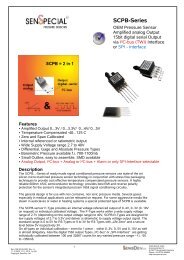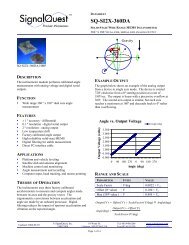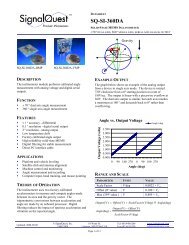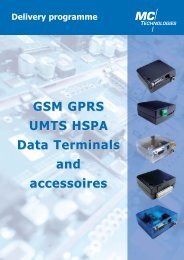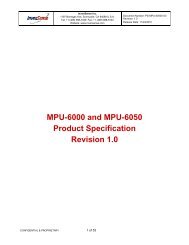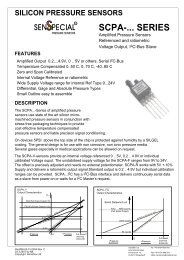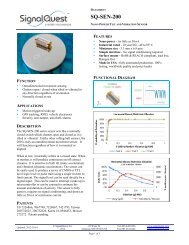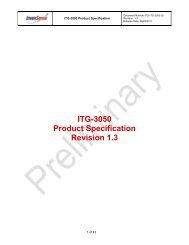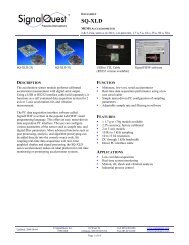MPU-6100 and MPU-6150 Product Specification Revision 1.2
MPU-6100 and MPU-6150 Product Specification Revision 1.2
MPU-6100 and MPU-6150 Product Specification Revision 1.2
You also want an ePaper? Increase the reach of your titles
YUMPU automatically turns print PDFs into web optimized ePapers that Google loves.
InvenSense Inc.1197 Borregas Ave, Sunnyvale, CA 94089 U.S.A.Tel: +1 (408) 988-7339 Fax: +1 (408) 988-8104Website: www.invensense.comDocument Number: PS-<strong>MPU</strong>-<strong>6100</strong>A-00<strong>Revision</strong>:<strong>1.2</strong>Release Date: 06/26/2012<strong>MPU</strong>-<strong>6100</strong> <strong>and</strong> <strong>MPU</strong>-<strong>6150</strong><strong>Product</strong> <strong>Specification</strong><strong>Revision</strong> <strong>1.2</strong>1 of 56
<strong>MPU</strong>-<strong>6100</strong>/<strong>MPU</strong>-<strong>6150</strong> <strong>Product</strong> <strong>Specification</strong>Document Number: PS-<strong>MPU</strong>-<strong>6100</strong>A-00<strong>Revision</strong>: <strong>1.2</strong>Release Date: 06/26/2012CONTENTS1 REVISION HISTORY ................................................................................................................................... 52 PURPOSE AND SCOPE ............................................................................................................................. 53 PRODUCT OVERVIEW ............................................................................................................................... 73.1 <strong>MPU</strong>-61X0 OVERVIEW ........................................................................................................................ 74 APPLICATIONS ........................................................................................................................................... 95 FEATURES ................................................................................................................................................ 105.1 GYROSCOPE FEATURES ..................................................................................................................... 105.2 ACCELEROMETER FEATURES ............................................................................................................. 105.3 ADDITIONAL FEATURES ...................................................................................................................... 105.4 MOTIONPROCESSING ......................................................................................................................... 115.5 CLOCKING ......................................................................................................................................... 116 ELECTRICAL CHARACTERISTICS ......................................................................................................... 126.1 GYROSCOPE SPECIFICATIONS ............................................................................................................ 126.2 ACCELEROMETER SPECIFICATIONS ..................................................................................................... 136.3 ELECTRICAL AND OTHER COMMON SPECIFICATIONS ............................................................................ 146.4 ELECTRICAL SPECIFICATIONS, CONTINUED ......................................................................................... 156.5 ELECTRICAL SPECIFICATIONS, CONTINUED ......................................................................................... 166.6 ELECTRICAL SPECIFICATIONS, CONTINUED ......................................................................................... 176.7 I 2 C TIMING CHARACTERIZATION.......................................................................................................... 186.8 SPI TIMING CHARACTERIZATION (<strong>MPU</strong>-<strong>6100</strong> ONLY) ........................................................................... 196.9 ABSOLUTE MAXIMUM RATINGS ........................................................................................................... 207 APPLICATIONS INFORMATION .............................................................................................................. 217.1 PIN OUT AND SIGNAL DESCRIPTION .................................................................................................... 217.2 TYPICAL OPERATING CIRCUIT ............................................................................................................. 227.3 BILL OF MATERIALS FOR EXTERNAL COMPONENTS .............................................................................. 227.4 RECOMMENDED POWER-ON PROCEDURE ........................................................................................... 237.5 BLOCK DIAGRAM ............................................................................................................................... 247.6 OVERVIEW ........................................................................................................................................ 247.7 THREE-AXIS MEMS GYROSCOPE WITH 16-BIT ADCS AND SIGNAL CONDITIONING ................................ 257.8 THREE-AXIS MEMS ACCELEROMETER WITH 16-BIT ADCS AND SIGNAL CONDITIONING ........................ 257.9 DIGITAL MOTION PROCESSOR ............................................................................................................ 257.10 PRIMARY I 2 C AND SPI SERIAL COMMUNICATIONS INTERFACES ............................................................ 257.11 AUXILIARY I 2 C SERIAL INTERFACE ...................................................................................................... 262 of 56
<strong>MPU</strong>-<strong>6100</strong>/<strong>MPU</strong>-<strong>6150</strong> <strong>Product</strong> <strong>Specification</strong>Document Number: PS-<strong>MPU</strong>-<strong>6100</strong>A-00<strong>Revision</strong>: <strong>1.2</strong>Release Date: 06/26/20127.12 SELF-TEST ........................................................................................................................................ 277.13 <strong>MPU</strong>-61X0 SOLUTION FOR 9-AXIS SENSOR FUSION USING I 2 C INTERFACE .......................................... 287.14 <strong>MPU</strong>-<strong>6100</strong> USING SPI INTERFACE ..................................................................................................... 297.15 INTERNAL CLOCK GENERATION .......................................................................................................... 307.16 SENSOR DATA REGISTERS ................................................................................................................. 307.17 FIFO ................................................................................................................................................ 307.18 INTERRUPTS ...................................................................................................................................... 317.19 DIGITAL-OUTPUT TEMPERATURE SENSOR .......................................................................................... 317.20 BIAS AND LDO .................................................................................................................................. 317.21 CHARGE PUMP .................................................................................................................................. 318 PROGRAMMABLE INTERRUPTS ............................................................................................................ 328.1 FREE FALL, MOTION, AND ZERO MOTION SIGNAL PATHS ..................................................................... 338.2 FREE FALL INTERRUPT ....................................................................................................................... 348.3 MOTION INTERRUPT ........................................................................................................................... 348.4 ZERO MOTION INTERRUPT .................................................................................................................. 359 DIGITAL INTERFACE ............................................................................................................................... 369.1 I 2 C AND SPI (<strong>MPU</strong>-<strong>6100</strong> ONLY) SERIAL INTERFACES .......................................................................... 369.2 I 2 C INTERFACE .................................................................................................................................. 369.3 I 2 C COMMUNICATIONS PROTOCOL ...................................................................................................... 369.4 I 2 C TERMS ........................................................................................................................................ 399.5 SPI INTERFACE (<strong>MPU</strong>-<strong>6100</strong> ONLY) .................................................................................................... 4010 SERIAL INTERFACE CONSIDERATIONS (<strong>MPU</strong>-<strong>6150</strong>).......................................................................... 4110.1 <strong>MPU</strong>-<strong>6150</strong> SUPPORTED INTERFACES ................................................................................................. 4110.2 LOGIC LEVELS ................................................................................................................................... 4110.3 LOGIC LEVELS DIAGRAM FOR AUX_VDDIO = 0 .................................................................................. 4210.4 LOGIC LEVELS DIAGRAM FOR AUX_VDDIO = 1 .................................................................................. 4311 ASSEMBLY ............................................................................................................................................... 4411.1 ORIENTATION OF AXES ...................................................................................................................... 441<strong>1.2</strong> PACKAGE DIMENSIONS ...................................................................................................................... 4511.3 PCB DESIGN GUIDELINES .................................................................................................................. 4611.4 ASSEMBLY PRECAUTIONS .................................................................................................................. 4711.5 STORAGE SPECIFICATIONS ................................................................................................................. 5011.6 PACKAGE MARKING SPECIFICATION .................................................................................................... 5011.7 TAPE & REEL SPECIFICATION ............................................................................................................. 513 of 56
<strong>MPU</strong>-<strong>6100</strong>/<strong>MPU</strong>-<strong>6150</strong> <strong>Product</strong> <strong>Specification</strong>Document Number: PS-<strong>MPU</strong>-<strong>6100</strong>A-00<strong>Revision</strong>: <strong>1.2</strong>Release Date: 06/26/201211.8 LABEL ............................................................................................................................................... 5211.9 PACKAGING ....................................................................................................................................... 5311.10 REPRESENTATIVE SHIPPING CARTON LABEL ................................................................................... 5412 RELIABILITY ............................................................................................................................................. 5512.1 QUALIFICATION TEST POLICY ............................................................................................................. 5512.2 QUALIFICATION TEST PLAN ................................................................................................................ 5513 ENVIRONMENTAL COMPLIANCE ........................................................................................................... 564 of 56
<strong>MPU</strong>-<strong>6100</strong>/<strong>MPU</strong>-<strong>6150</strong> <strong>Product</strong> <strong>Specification</strong>Document Number: PS-<strong>MPU</strong>-<strong>6100</strong>A-00<strong>Revision</strong>: <strong>1.2</strong>Release Date: 06/26/20121 <strong>Revision</strong> History<strong>Revision</strong>Date<strong>Revision</strong>Description11/24/2010 1.0 Initial Release02/02/2012 1.1 Updated gyroscope (ZRO) <strong>and</strong> accelerometer specifications (sections 6.1 <strong>and</strong>6.2)Updated gyroscope (max ±14%) <strong>and</strong> accelerometer (max ±14%) self-testspecifications (sections 6.1, 6.2) <strong>and</strong> clarified self-test description (section 7.12)Updated absolute maximum ratings table (MM, LU; Section 6.9)Added cautionary note recommending no under-fill (Section 11.4.2)Updated package shipping (5 pizza boxes, 25K quantity) <strong>and</strong> label information(Sections 11.7 through 11.9)Updated JEDEC references in reliability information (Section 12.2)06/26/2012 <strong>1.2</strong> Updated accelerometer specifications (sections 6.2)5 of 56
<strong>MPU</strong>-<strong>6100</strong>/<strong>MPU</strong>-<strong>6150</strong> <strong>Product</strong> <strong>Specification</strong>Document Number: PS-<strong>MPU</strong>-<strong>6100</strong>A-00<strong>Revision</strong>: <strong>1.2</strong>Release Date: 06/26/20122 Purpose <strong>and</strong> ScopeThis product specification provides advanced information regarding the electrical specification <strong>and</strong> designrelated information for the <strong>MPU</strong>-<strong>6100</strong> <strong>and</strong> <strong>MPU</strong>-<strong>6150</strong> MotionTracking devices, collectively called the<strong>MPU</strong>-61x0 or <strong>MPU</strong>.Electrical characteristics are based upon design analysis <strong>and</strong> simulation results only. <strong>Specification</strong>s aresubject to change without notice. Final specifications will be updated based upon characterization ofproduction silicon. For references to register map <strong>and</strong> descriptions of individual registers, please refer to the<strong>MPU</strong>-<strong>6100</strong>/<strong>MPU</strong>-<strong>6150</strong> Register Map <strong>and</strong> Register Descriptions document.6 of 56
<strong>MPU</strong>-<strong>6100</strong>/<strong>MPU</strong>-<strong>6150</strong> <strong>Product</strong> <strong>Specification</strong>Document Number: PS-<strong>MPU</strong>-<strong>6100</strong>A-00<strong>Revision</strong>: <strong>1.2</strong>Release Date: 06/26/20123 <strong>Product</strong> Overview3.1 <strong>MPU</strong>-61x0 OverviewMotionInterface is rapidly becoming a key function in many consumer electronics devices as it provides anintuitive way for consumers to interact with electronic devices by tracking motion in free space <strong>and</strong> deliveringthese motions as input comm<strong>and</strong>s.Traditional multi-button based remote controls are difficult to use when browsing <strong>and</strong> selecting content on aSmart TV <strong>and</strong> touch pads <strong>and</strong> keyboards can be expensive <strong>and</strong> difficult to use in the living roomenvironment.The <strong>MPU</strong>-<strong>6100</strong> <strong>and</strong> <strong>MPU</strong>-<strong>6150</strong> (collectively called the <strong>MPU</strong>-61x0) with MotionFusion <strong>and</strong> run-timecalibration firmware enable consumer electronics manufacturers to commercialize cost effective motionbasedremote controls that enable a more intuitive motion interface for smart-TVs, set top boxes, <strong>and</strong> gamingplatforms.The <strong>MPU</strong>-61x0, is the world’s first <strong>and</strong> only single chip 6-axis MotionTracking device designed for the lowpower, low cost, <strong>and</strong> high performance requirements of Smart TVs, set top boxes , <strong>and</strong> gaming consoleremote control applications. The <strong>MPU</strong>-61x0 incorporates InvenSense’s MotionFusion <strong>and</strong> run-timecalibration firmware that enables manufacturers to eliminate the costly <strong>and</strong> complex selection, qualification,<strong>and</strong> system level integration of discrete devices in motion-based remote controls, <strong>and</strong> guarantees thatsensor fusion algorithms <strong>and</strong> calibration procedures deliver optimal performance for consumers.Accurately tracking complex user motions for remote control applications requires a 3-axis gyroscope, a 3-axis accelerometer, fusing the sensor outputs into a single <strong>and</strong> accurate data stream for use as inputcomm<strong>and</strong>s by the TV or gaming console, <strong>and</strong> ongoing run-time calibration to ensure the best possible userexperience. The single chip 6-axis <strong>MPU</strong>-61x0 combines an accelerometer <strong>and</strong> gyroscope into a very small4x4x0.9 mm QFN package, with an onboard Digital Motion Processor (DMP) that h<strong>and</strong>les MotionFusion<strong>and</strong> ongoing run-time calibration. By offloading sensor fusion <strong>and</strong> run-time calibration to the DMP, remotecontrol manufacturers can use less expensive microcontrollers, while also extending remote control batterylife since less data is transmitted for external processing on the TV or gaming platform SoC. Additionally, ascalibration <strong>and</strong> sensor fusion are performed on <strong>MPU</strong>-61x0 based remote controls, TV <strong>and</strong> gaming consoleSoCs no longer need to spend valuable CPU b<strong>and</strong>width <strong>and</strong> associated power processing the motion sensordata for use by software applications.The <strong>MPU</strong>-61x0 MotionTracking device includes an auxiliary I 2 C port that interfaces to 3 rd party digital sensorssuch as magnetometers. When connected to a 3-axis magnetometer, the <strong>MPU</strong>-61x0 delivers a complete 9-axis MotionFusion output to its primary I 2 C or SPI port (SPI is available on <strong>MPU</strong>-<strong>6100</strong> only). The <strong>MPU</strong>-61x0combines acceleration <strong>and</strong> rotational motion plus heading information into a single data stream for theapplication. This MotionTracking technology integration provides a smaller footprint <strong>and</strong> has inherent costadvantages compared to discrete gyroscope plus accelerometer solutions. The <strong>MPU</strong>-61x0 is also designedto interface with multiple non-inertial digital sensors, such as pressure sensors, on its auxiliary I 2 C port. The<strong>MPU</strong>-61x0 is a 2 nd generation motion processor <strong>and</strong> is footprint compatible with the <strong>MPU</strong>-30x0 family.The <strong>MPU</strong>-61x0 features three 16-bit analog-to-digital converters (ADCs) for digitizing the gyroscope outputs<strong>and</strong> three 16-bit ADCs for digitizing the accelerometer outputs. For precision tracking of both fast <strong>and</strong> slowmotions, the parts feature a user-programmable gyroscope full-scale range of ±250, ±500, ±1000, <strong>and</strong>±2000°/sec (dps) <strong>and</strong> a user-programmable accelerometer full-scale range of ±2g, ±4g, ±8g, <strong>and</strong> ±16g.An on-chip 1024 Byte FIFO buffer helps lower system power consumption by allowing the system processorto read the sensor data in bursts <strong>and</strong> then enter a low-power mode as the <strong>MPU</strong> collects more data. With allthe necessary on-chip processing <strong>and</strong> sensor components required to support many motion-based usecases, the <strong>MPU</strong>-61x0 uniquely supports a variety of advanced motion-based applications entirely on-chip.The <strong>MPU</strong>-61x0 thus enables low-power MotionProcessing in portable applications with reduced processingrequirements for the system processor. By providing an integrated MotionFusion output, the DMP in the7 of 56
<strong>MPU</strong>-<strong>6100</strong>/<strong>MPU</strong>-<strong>6150</strong> <strong>Product</strong> <strong>Specification</strong>Document Number: PS-<strong>MPU</strong>-<strong>6100</strong>A-00<strong>Revision</strong>: <strong>1.2</strong>Release Date: 06/26/2012<strong>MPU</strong>-61x0 offloads the intensive MotionProcessing computation requirements from the system processor,minimizing the need for frequent polling of the motion sensor output.Communication with all registers of the device is performed using either I 2 C at 400kHz or SPI at 1MHz(<strong>MPU</strong>-<strong>6100</strong> only). For applications requiring faster communications, the sensor <strong>and</strong> interrupt registers maybe read using SPI at 20MHz (<strong>MPU</strong>-<strong>6100</strong> only). Additional features include an embedded temperature sensor<strong>and</strong> an on-chip oscillator with ±1% variation over the operating temperature range.By leveraging its patented <strong>and</strong> volume-proven Nasiri-Fabrication platform, which integrates MEMS waferswith companion CMOS electronics through wafer-level bonding, InvenSense has driven the <strong>MPU</strong>-61x0package size down to a revolutionary footprint of 4x4x0.9mm (QFN), while providing the highestperformance, lowest noise, <strong>and</strong> the lowest cost semiconductor packaging required for h<strong>and</strong>held consumerelectronic devices. The part features a robust 10,000g shock tolerance, <strong>and</strong> has programmable low-passfilters for the gyroscopes, accelerometers, <strong>and</strong> the on-chip temperature sensor.For power supply flexibility, the <strong>MPU</strong>-61x0 operates from VDD power supply voltage range of 2.375V-3.46V.Additionally, the <strong>MPU</strong>-<strong>6150</strong> provides a VLOGIC reference pin (in addition to its analog supply pin: VDD),which sets the logic levels of its I 2 C interface. The VLOGIC voltage may be 1.8V±5% or VDD.The <strong>MPU</strong>-<strong>6100</strong> <strong>and</strong> <strong>MPU</strong>-<strong>6150</strong> are identical, except that the <strong>MPU</strong>-<strong>6150</strong> supports the I 2 C serial interface only,<strong>and</strong> has a separate VLOGIC reference pin. The <strong>MPU</strong>-<strong>6100</strong> supports both I 2 C <strong>and</strong> SPI interfaces <strong>and</strong> has asingle supply pin, VDD, which is both the device’s logic reference supply <strong>and</strong> the analog supply for the part.The table below outlines these differences:Primary Differences between <strong>MPU</strong>-<strong>6100</strong> <strong>and</strong> <strong>MPU</strong>-<strong>6150</strong>Part / Item <strong>MPU</strong>-<strong>6100</strong> <strong>MPU</strong>-<strong>6150</strong>VDD 2.375V-3.46V 2.375V-3.46VVLOGIC n/a 1.71V to VDDSerial Interfaces Supported I 2 C, SPI I 2 CPin 8 /CS VLOGICPin 9 AD0/SDO AD0Pin 23 SCL/SCLK SCLPin 24 SDA/SDI SDA8 of 56
<strong>MPU</strong>-<strong>6100</strong>/<strong>MPU</strong>-<strong>6150</strong> <strong>Product</strong> <strong>Specification</strong>Document Number: PS-<strong>MPU</strong>-<strong>6100</strong>A-00<strong>Revision</strong>: <strong>1.2</strong>Release Date: 06/26/20124 Applications 3D remote controls for Internet connected DTVs <strong>and</strong> set top boxes, 3D mice Motion-based game controllers Portable gaming AirSign technology (for Security/Authentication) TouchAnywhere technology (for “no touch” UI Application Control/Navigation) MotionComm<strong>and</strong> technology (for Gesture Short-cuts)InstantGesture iG gesture recognition9 of 56
<strong>MPU</strong>-<strong>6100</strong>/<strong>MPU</strong>-<strong>6150</strong> <strong>Product</strong> <strong>Specification</strong>Document Number: PS-<strong>MPU</strong>-<strong>6100</strong>A-00<strong>Revision</strong>: <strong>1.2</strong>Release Date: 06/26/20125 Features5.1 Gyroscope FeaturesThe triple-axis MEMS gyroscope in the <strong>MPU</strong>-61x0 includes a wide range of features: Digital-output X-, Y-, <strong>and</strong> Z-Axis angular rate sensors (gyroscopes) with a user-programmable fullscalerange of ±250, ±500, ±1000, <strong>and</strong> ±2000°/sec External sync signal connected to the FSYNC pin supports image, video <strong>and</strong> GPS synchronization Integrated 16-bit ADCs enable simultaneous sampling of gyros Enhanced bias <strong>and</strong> sensitivity temperature stability reduces the need for user calibration Improved low-frequency noise performance Digitally-programmable low-pass filter Gyroscope operating current: 3.6mA St<strong>and</strong>by current: 5µA Factory calibrated sensitivity scale factor User self-test5.2 Accelerometer FeaturesThe triple-axis MEMS accelerometer in <strong>MPU</strong>-61x0 includes a wide range of features: Digital-output triple-axis accelerometer with a programmable full scale range of ±2g, ±4g, ±8g <strong>and</strong>±16g Integrated 16-bit ADCs enable simultaneous sampling of accelerometers while requiring no externalmultiplexer Accelerometer normal operating current: 500µA Low power accelerometer mode current: 10µA at <strong>1.2</strong>5Hz, 20µA at 5Hz, 60µA at 20Hz, 110µA at40Hz Orientation detection <strong>and</strong> signaling Tap detection User-programmable interrupts Free-fall interrupt High-G interrupt Zero Motion/Motion interrupt User self-test5.3 Additional FeaturesThe <strong>MPU</strong>-61x0 includes the following additional features:9-Axis MotionFusion by the on-chip Digital Motion Processor (DMP)Auxiliary master I 2 C bus for reading data from external sensors (e.g., magnetometer)3.9mA operating current when all 6 motion sensing axes <strong>and</strong> the DMP are enabledVDD supply voltage range of 2.375V-3.46VFlexible VLOGIC reference voltage supports multiple I 2 C interface voltages (<strong>MPU</strong>-<strong>6150</strong> only)Smallest <strong>and</strong> thinnest QFN package for portable devices: 4x4x0.9mmMinimal cross-axis sensitivity between the accelerometer <strong>and</strong> gyroscope axes1024 byte FIFO buffer reduces power consumption by allowing host processor to read the data inbursts <strong>and</strong> then go into a low-power mode as the <strong>MPU</strong> collects more dataDigital-output temperature sensorUser-programmable digital filters for gyroscope, accelerometer, <strong>and</strong> temp sensor10,000 g shock tolerant400kHz Fast Mode I 2 C for communicating with all registers10 of 56
<strong>MPU</strong>-<strong>6100</strong>/<strong>MPU</strong>-<strong>6150</strong> <strong>Product</strong> <strong>Specification</strong>Document Number: PS-<strong>MPU</strong>-<strong>6100</strong>A-00<strong>Revision</strong>: <strong>1.2</strong>Release Date: 06/26/20121MHz SPI serial interface for communicating with all registers (<strong>MPU</strong>-<strong>6100</strong> only)20MHz SPI serial interface for reading sensor <strong>and</strong> interrupt registers (<strong>MPU</strong>-<strong>6100</strong> only)MEMS structure hermetically sealed <strong>and</strong> bonded at wafer levelRoHS <strong>and</strong> Green compliant5.4 MotionProcessing Internal Digital Motion Processing (DMP) engine supports 3D MotionProcessing <strong>and</strong> gesturerecognition algorithms The <strong>MPU</strong>-61x0 collects gyroscope <strong>and</strong> accelerometer data while synchronizing data sampling at auser defined rate. The total dataset obtained by the <strong>MPU</strong>-61x0 includes 3-Axis gyroscope data, 3-Axis accelerometer data, <strong>and</strong> temperature data. The <strong>MPU</strong>’s calculated output to the systemprocessor can also include heading data from a digital 3-axis third party magnetometer. The FIFO buffers the complete data set, reducing timing requirements on the system processor byallowing the processor burst read the FIFO data. After burst reading the FIFO data, the systemprocessor can save power by entering a low-power sleep mode while the <strong>MPU</strong> collects more data. Programmable interrupt supports features such as gesture recognition, panning, zooming, scrolling,zero-motion detection, tap detection, <strong>and</strong> shake detection Digitally-programmable low-pass filters Low-power pedometer functionality allows the host processor to sleep while the DMP maintains thestep count.5.5 Clocking On-chip timing generator ±1% frequency variation over full temperature range Optional external clock inputs of 32.768kHz or 19.2MHz11 of 56
<strong>MPU</strong>-<strong>6100</strong>/<strong>MPU</strong>-<strong>6150</strong> <strong>Product</strong> <strong>Specification</strong>Document Number: PS-<strong>MPU</strong>-<strong>6100</strong>A-00<strong>Revision</strong>: <strong>1.2</strong>Release Date: 06/26/20126 Electrical Characteristics6.1 Gyroscope <strong>Specification</strong>sVDD = 2.375V-3.46V, VLOGIC (<strong>MPU</strong>-<strong>6150</strong> only) = 1.8V±5% or VDD, T A = 25°CPARAMETER CONDITIONS MIN TYP MAX UNITS NOTESGYROSCOPE SENSITIVITYFull-Scale Range FS_SEL=0 ±250 º/sFS_SEL=1 ±500 º/sFS_SEL=2 ±1000 º/sFS_SEL=3 ±2000 º/sGyroscope ADC Word Length 16 bitsSensitivity Scale Factor FS_SEL=0 131 LSB/(º/s)FS_SEL=1 65.5 LSB/(º/s)FS_SEL=2 32.8 LSB/(º/s)FS_SEL=3 16.4 LSB/(º/s)Sensitivity Scale Factor Tolerance 25°C -3 +3 %Sensitivity Scale Factor Variation Over±2 %TemperatureNonlinearity Best fit straight line; 25°C 0.2 %Cross-Axis Sensitivity ±2 %GYROSCOPE ZERO-RATE OUTPUT (ZRO)Initial ZRO Tolerance 25°C ±25 º/sZRO Variation Over Temperature -40°C to +85°C ±30 º/sPower-Supply Sensitivity (1-10Hz) Sine wave, 100mVpp; VDD=2.5V 0.2 º/sPower-Supply Sensitivity (10 - 250Hz) Sine wave, 100mVpp; VDD=2.5V 0.2 º/sPower-Supply Sensitivity (250Hz - 100kHz) Sine wave, 100mVpp; VDD=2.5V 4 º/sLinear Acceleration Sensitivity Static 0.1 º/s/gSELF-TEST RESPONSEChange from factory trim -14 14 %GYROSCOPE NOISE PERFORMANCE FS_SEL=0Total RMS Noise DLPFCFG=2 (100Hz) 0.2 º/s-rmsGYROSCOPE MECHANICALFREQUENCIESX-Axis 30 33 36 kHzY-Axis 27 30 33 kHzZ-Axis 24 27 30 kHzLOW PASS FILTER RESPONSEProgrammable Range 5 256 HzOUTPUT DATA RATEProgrammable 4 8,000 HzGYROSCOPE START-UP TIMEDLPFCFG=0ZRO Settling to ±1º/s of Final 30 ms12 of 56
<strong>MPU</strong>-<strong>6100</strong>/<strong>MPU</strong>-<strong>6150</strong> <strong>Product</strong> <strong>Specification</strong>Document Number: PS-<strong>MPU</strong>-<strong>6100</strong>A-00<strong>Revision</strong>: <strong>1.2</strong>Release Date: 06/26/20126.2 Accelerometer <strong>Specification</strong>sVDD = 2.375V-3.46V, VLOGIC (<strong>MPU</strong>-<strong>6150</strong> only) = 1.8V±5% or VDD, T A = 25°CPARAMETER CONDITIONS MIN TYP MAX UNITS NOTESACCELEROMETER SENSITIVITYFull-Scale Range AFS_SEL=0 ±2 gAFS_SEL=1 ±4 gAFS_SEL=2 ±8 gAFS_SEL=3 ±16 gADC Word Length Output in two’s complement format 16 bitsSensitivity Scale Factor AFS_SEL=0 16,384 LSB/gAFS_SEL=1 8,192 LSB/gAFS_SEL=2 4,096 LSB/gAFS_SEL=3 2,048 LSB/gInitial Calibration Tolerance ±3 %Sensitivity Change vs. Temperature AFS_SEL=0, -40°C to +85°C ±0.02 %/°CNonlinearity Best Fit Straight Line 0.5 %Cross-Axis Sensitivity ±2 %ZERO-G OUTPUTInitial Calibration ToleranceZero-G Output With Factory Self Test<strong>and</strong> In-Use CalibrationZero-G Level Change vs. TemperatureComponent LevelBoard LevelAll Axes±80±120±30mg1mgmg 2X <strong>and</strong> Y axes, 0°C to +70°C±35Z axis, 0°C to +70°C ±60 mgSELF TEST RESPONSEChange from factory trim -14 14 %NOISE PERFORMANCEPower Spectral Density @10Hz, AFS_SEL=0 & ODR=1kHz 400 g/√HzLOW PASS FILTER RESPONSEProgrammable Range 5 260 HzOUTPUT DATA RATEProgrammable Range 4 1,000 HzINTELLIGENCE FUNCTIONINCREMENT 1 mg/LSB1. Typical zero-g initial calibration tolerance value after MSL3 preconditioning2. Requires integration <strong>and</strong> validation on customer specific processor. In-Use Calibration is a proprietary softwarealgorithm available from InvenSense as part of MotionApps <strong>and</strong> can be enabled to run in the background at alltimes to continuously calibrate the 3-axis accelerometer during normal h<strong>and</strong>set use. For further information onIn-Use Calibration please see: App Note - Accel In-Use Calibration (AN-MAPPS-0.0.1)13 of 56
<strong>MPU</strong>-<strong>6100</strong>/<strong>MPU</strong>-<strong>6150</strong> <strong>Product</strong> <strong>Specification</strong>Document Number: PS-<strong>MPU</strong>-<strong>6100</strong>A-00<strong>Revision</strong>: <strong>1.2</strong>Release Date: 06/26/20126.3 Electrical <strong>and</strong> Other Common <strong>Specification</strong>sVDD = 2.375V-3.46V, VLOGIC (<strong>MPU</strong>-<strong>6150</strong> only) = 1.8V±5% or VDD, T A = 25°CPARAMETER CONDITIONS MIN TYP MAX Units NotesTEMPERATURE SENSORRange -40 to +85 °CSensitivity Untrimmed 340 LSB/ºCTemperature Offset 35 o C -521 LSBLinearityBest fit straight line (-40°C to+85°C)±1 °CVDD POWER SUPPLYOperating Voltages 2.375 3.46 VNormal Operating Current Gyroscope + Accelerometer + DMP 3.9 mAAccelerometer Low Power ModeCurrentGyroscope + Accelerometer(DMP disabled) 3.8 mAGyroscope + DMP(Accelerometer disabled) 3.7 mAGyroscope only(DMP & Accelerometer disabled) 3.6 mAAccelerometer only(DMP & Gyroscope disabled) 500 µA1 Hz update rate 10 µA5 Hz update rate 20 µA20 Hz update rate 70 µA40 Hz update rate 140 µAFull-Chip Idle Mode Supply Current 5 µAPower Supply Ramp Rate Monotonic ramp. Ramp rate is 10%to 90% of the final value100 msVLOGIC REFERENCE VOLTAGE <strong>MPU</strong>-<strong>6150</strong> onlyVoltage Range VLOGIC must be ≤VDD at all times 1.71 VDD VPower Supply Ramp Rate Monotonic ramp. Ramp rate is 10%to 90% of the final value3 msNormal Operating Current 100 µASTART-UP TIME FOR REGISTERREAD/WRITE20 100 msTEMPERATURE RANGESpecified Temperature RangePerformance parameters are notapplicable beyond SpecifiedTemperature Range-40 +85 °C14 of 56
<strong>MPU</strong>-<strong>6100</strong>/<strong>MPU</strong>-<strong>6150</strong> <strong>Product</strong> <strong>Specification</strong>Document Number: PS-<strong>MPU</strong>-<strong>6100</strong>A-00<strong>Revision</strong>: <strong>1.2</strong>Release Date: 06/26/20126.4 Electrical <strong>Specification</strong>s, ContinuedVDD = 2.375V-3.46V, VLOGIC (<strong>MPU</strong>-<strong>6150</strong> only) = 1.8V±5% or VDD, T A = 25°CPARAMETER CONDITIONS MIN TYP MAX Units NotesSERIAL INTERFACESPI Operating Frequency, All <strong>MPU</strong>-<strong>6100</strong> only, Low SpeedRegisters Read/WriteCharacterization100 ±10% kHz<strong>MPU</strong>-<strong>6100</strong> only, High SpeedCharacterization1 ±10% MHzSPI Operating Frequency, Sensor <strong>MPU</strong>-<strong>6100</strong> only<strong>and</strong> Interrupt Registers Read Only20 ±10% MHzI 2 C Operating Frequency All registers, Fast-mode 400 kHzAll registers, St<strong>and</strong>ard-mode 100 kHzI 2 C ADDRESS AD0 = 0 1101000AD0 = 1 1101001DIGITAL INPUTS (SDI/SDA, AD0,SCLK/SCL, FSYNC, /CS, CLKIN)V IH, High Level Input Voltage <strong>MPU</strong>-<strong>6100</strong> 0.7*VDD V<strong>MPU</strong>-<strong>6150</strong> 0.7*VLOGIC VV IL, Low Level Input Voltage <strong>MPU</strong>-<strong>6100</strong> 0.3*VDD V<strong>MPU</strong>-<strong>6150</strong> 0.3*VLOGIC VC I, Input Capacitance < 5 pFDIGITAL OUTPUT (SDO, INT)V OH, High Level Output Voltage R LOAD=1MΩ; <strong>MPU</strong>-<strong>6100</strong> 0.9*VDD VR LOAD=1MΩ; <strong>MPU</strong>-<strong>6150</strong> 0.9*VLOGIC VV OL1, LOW-Level Output Voltage R LOAD=1MΩ; <strong>MPU</strong>-<strong>6100</strong> 0.1*VDD VV OL.INT1, INT Low-Level OutputVoltageR LOAD=1MΩ; <strong>MPU</strong>-<strong>6150</strong> 0.1*VLOGIC VOPEN=1, 0.3mA sinkCurrent0.1 VOutput Leakage Current OPEN=1 100 nAt INT, INT Pulse Width LATCH_INT_EN=0 50 µsDIGITAL OUTPUT (CLKOUT)V OH, High Level Output VoltageV OL1, LOW-Level Output VoltageR LOAD=1MΩR LOAD=1MΩ0.9*VDD0.1*VDDVV15 of 56
<strong>MPU</strong>-<strong>6100</strong>/<strong>MPU</strong>-<strong>6150</strong> <strong>Product</strong> <strong>Specification</strong>Document Number: PS-<strong>MPU</strong>-<strong>6100</strong>A-00<strong>Revision</strong>: <strong>1.2</strong>Release Date: 06/26/20126.5 Electrical <strong>Specification</strong>s, ContinuedTypical Operating Circuit of Section 7.2, VDD = 2.375V-3.46V, VLOGIC (<strong>MPU</strong>-<strong>6150</strong> only) = 1.8V±5% orVDD, T A = 25°CParameters Conditions Typical Units NotesPrimary I 2 C I/O (SCL, SDA)V IL, LOW-Level Input Voltage <strong>MPU</strong>-<strong>6100</strong> -0.5 to 0.3*VDD VV IH, HIGH-Level Input Voltage <strong>MPU</strong>-<strong>6100</strong> 0.7*VDD to VDD + 0.5V VV hys, Hysteresis <strong>MPU</strong>-<strong>6100</strong> 0.1*VDD VVIL, LOW Level Input Voltage <strong>MPU</strong>-<strong>6150</strong> -0.5V to 0.3*VLOGIC VVIH, HIGH-Level Input Voltage <strong>MPU</strong>-<strong>6150</strong> 0.7*VLOGIC to VLOGIC + 0.5V VVhys, Hysteresis <strong>MPU</strong>-<strong>6150</strong> 0.1*VLOGIC VV OL1, LOW-Level Output Voltage 3mA sink current 0 to 0.4 VI OL, LOW-Level Output Current V OL = 0.4V 3 mAV OL = 0.6V 5 mAOutput Leakage Current 100 nAt of, Output Fall Time from V IHmax to V ILmax C b bus capacitance in pF 20+0.1C b to 250 nsC I, Capacitance for Each I/O pin < 10 pFAuxiliary I 2 C I/O (AUX_CL, AUX_DA) <strong>MPU</strong>-<strong>6150</strong>: AUX_VDDIO=0V IL, LOW-Level Input Voltage -0.5V to 0.3*VLOGIC VV IH, HIGH-Level Input Voltage0.7*VLOGIC toVVLOGIC + 0.5VV hys, Hysteresis 0.1*VLOGIC VV OL1, LOW-Level Output Voltage VLOGIC > 2V; 1mA sink current 0 to 0.4 VV OL3, LOW-Level Output Voltage VLOGIC < 2V; 1mA sink current 0 to 0.2*VLOGIC VI OL, LOW-Level Output Current V OL = 0.4VV OL = 0.6V11mAmAOutput Leakage Current 100 nAt of, Output Fall Time from V IHmax to V ILmax C b bus capacitance in pF 20+0.1C b to 250 nsC I, Capacitance for Each I/O pin < 10 pFAuxiliary I 2 C I/O (AUX_CL, AUX_DA) <strong>MPU</strong>-<strong>6150</strong>: AUX_VDDIO=1;<strong>MPU</strong>-<strong>6100</strong>V IL, LOW-Level Input Voltage -0.5 to 0.3*VDD VV IH, HIGH-Level Input Voltage 0.7*VDD to VDD+0.5V VV hys, Hysteresis 0.1*VDD VV OL1, LOW-Level Output Voltage 1mA sink current 0 to 0.4 VI OL, LOW-Level Output Current V OL = 0.4VV OL = 0.6VOutput Leakage Current 100 nAt of, Output Fall Time from V IHmax to V ILmax C b bus cap. in pF 20+0.1C b to 250 nsC I, Capacitance for Each I/O pin < 10 pF11mAmA16 of 56
<strong>MPU</strong>-<strong>6100</strong>/<strong>MPU</strong>-<strong>6150</strong> <strong>Product</strong> <strong>Specification</strong>Document Number: PS-<strong>MPU</strong>-<strong>6100</strong>A-00<strong>Revision</strong>: <strong>1.2</strong>Release Date: 06/26/20126.6 Electrical <strong>Specification</strong>s, ContinuedTypical Operating Circuit of Section 7.2, VDD = 2.375V-3.46V, VLOGIC (<strong>MPU</strong>-<strong>6150</strong> only) = 1.8V±5% orVDD, T A = 25°CParameters Conditions Min Typical Max Units NotesINTERNAL CLOCK SOURCEGyroscope Sample Rate, FastCLK_SEL=0,1,2,3DLPFCFG=0SAMPLERATEDIV = 0Gyroscope Sample Rate, Slow DLPFCFG=1,2,3,4,5, or 6SAMPLERATEDIV = 08 kHz1 kHzAccelerometer Sample Rate 1 kHzReference Clock Output CLKOUTEN = 1 1.024 MHzClock Frequency Initial Tolerance CLK_SEL=0, 25°C -5 +5 %CLK_SEL=1,2,3; 25°C -1 +1 %Frequency Variation over Temperature CLK_SEL=0 -15 to +10 %CLK_SEL=1,2,3 ±1 %PLL Settling Time CLK_SEL=1,2,3 1 10 msEXTERNAL 32.768kHz CLOCKCLK_SEL=4External Clock Frequency 32.768 kHzExternal Clock Allowable Jitter Cycle-to-cycle rms 1 to 2 µsGyroscope Sample Rate, FastDLPFCFG=0SAMPLERATEDIV = 08.192 kHzGyroscope Sample Rate, Slow DLPFCFG=1,2,3,4,5, or 6SAMPLERATEDIV = 01.024 kHzAccelerometer Sample Rate 1.024 kHzReference Clock Output CLKOUTEN = 1 1.0486 MHzPLL Settling Time 1 10 msEXTERNAL 19.2MHz CLOCKCLK_SEL=5External Clock Frequency 19.2 MHzGyroscope Sample Rate Full programmable range 3.9 8000 HzGyroscope Sample Rate, Fast Mode DLPFCFG=0SAMPLERATEDIV = 08 kHzGyroscope Sample Rate, Slow Mode DLPFCFG=1,2,3,4,5, or 6SAMPLERATEDIV = 01 kHzAccelerometer Sample Rate 1 kHzReference Clock Output CLKOUTEN = 1 1.024 MHzPLL Settling Time 1 10 ms17 of 56
<strong>MPU</strong>-<strong>6100</strong>/<strong>MPU</strong>-<strong>6150</strong> <strong>Product</strong> <strong>Specification</strong>Document Number: PS-<strong>MPU</strong>-<strong>6100</strong>A-00<strong>Revision</strong>: <strong>1.2</strong>Release Date: 06/26/20126.7 I 2 C Timing CharacterizationTypical Operating Circuit of Section 7.2, VDD = 2.375V-3.46V, VLOGIC (<strong>MPU</strong>-<strong>6150</strong> only) = 1.8V±5% orVDD, T A = 25°CParameters Conditions Min Typical Max Units NotesI 2 C TIMINGI 2 C FAST-MODEf SCL, SCL Clock Frequency 400 kHzt HD.STA, (Repeated) START Condition Hold0.6 µsTimet LOW, SCL Low Period 1.3 µst HIGH, SCL High Period 0.6 µst SU.STA, Repeated START Condition Setup0.6 µsTimet HD.DAT, SDA Data Hold Time 0 µst SU.DAT, SDA Data Setup Time 100 nst r, SDA <strong>and</strong> SCL Rise Time C b bus cap. from 10 to 400pF 20+0.1C b 300 nst f, SDA <strong>and</strong> SCL Fall Time C b bus cap. from 10 to 400pF 20+0.1C b 300 nst SU.STO, STOP Condition Setup Time 0.6 µst BUF, Bus Free Time Between STOP <strong>and</strong>1.3 µsSTART ConditionC b, Capacitive Load for each Bus Line < 400 pFt VD.DAT, Data Valid Time 0.9 µst VD.ACK, Data Valid Acknowledge Time 0.9 µsNote: Timing Characteristics apply to both Primary <strong>and</strong> Auxiliary I 2 C BusI 2 C Bus Timing Diagram18 of 56
<strong>MPU</strong>-<strong>6100</strong>/<strong>MPU</strong>-<strong>6150</strong> <strong>Product</strong> <strong>Specification</strong>Document Number: PS-<strong>MPU</strong>-<strong>6100</strong>A-00<strong>Revision</strong>: <strong>1.2</strong>Release Date: 06/26/20126.8 SPI Timing Characterization (<strong>MPU</strong>-<strong>6100</strong> only)Typical Operating Circuit of Section 7.2, VDD = 2.375V-3.46V, VLOGIC (<strong>MPU</strong>-<strong>6150</strong> only) = 1.8V±5% orVDD,T A = 25°C, unless otherwise noted.Parameters Conditions Min Typical Max Units NotesSPI TIMINGf SCLK, SCLK Clock Frequency 1 MHzt LOW, SCLK Low Period 400 nst HIGH, SCLK High Period 400 nst SU.CS, CS Setup Time 8 nst HD.CS, CS Hold Time 500 nst SU.SDI, SDI Setup Time 11 nst HD.SDI, SDI Hold Time 7 nst VD.SDO, SDO Valid Time C load = 20pF 100 nst HD.SDO, SDO Hold Time C load = 20pF 4 nst DIS.SDO, SDO Output Disable Time 10 nsSPI Bus Timing Diagram19 of 56
<strong>MPU</strong>-<strong>6100</strong>/<strong>MPU</strong>-<strong>6150</strong> <strong>Product</strong> <strong>Specification</strong>Document Number: PS-<strong>MPU</strong>-<strong>6100</strong>A-00<strong>Revision</strong>: <strong>1.2</strong>Release Date: 06/26/20126.9 Absolute Maximum RatingsStress above those listed as “Absolute Maximum Ratings” may cause permanent damage to the device.These are stress ratings only <strong>and</strong> functional operation of the device at these conditions is not implied.Exposure to the absolute maximum ratings conditions for extended periods may affect device reliability.ParameterRatingSupply Voltage, VDD -0.5V to +6VVLOGIC Input Voltage Level (<strong>MPU</strong>-<strong>6150</strong>) -0.5V to VDD + 0.5VREGOUTInput Voltage Level (CLKIN, AUX_DA, AD0, FSYNC, INT,SCL, SDA)CPOUT (2.5V ≤ VDD ≤ 3.6V )Acceleration (Any Axis, unpowered)Operating Temperature RangeStorage Temperature RangeElectrostatic Discharge (ESD) ProtectionLatch-up-0.5V to 2V-0.5V to VDD + 0.5V-0.5V to 30V10,000g for 0.2ms-40°C to +105°C-40°C to +125°C2kV (HBM);250V (MM)JEDEC Class II (2),125°C, ±100mA20 of 56
SDA/SDIAUX_CL/CSSCL/SCLKAD0/SDOCLKOUTREGOUTRESVFSYNCCPOUTRESVINTSDAAUX_CLVLOGICSCLAD0CLKOUTREGOUTRESVFSYNCCPOUTRESVINT<strong>MPU</strong>-<strong>6100</strong>/<strong>MPU</strong>-<strong>6150</strong> <strong>Product</strong> <strong>Specification</strong>Document Number: PS-<strong>MPU</strong>-<strong>6100</strong>A-00<strong>Revision</strong>: <strong>1.2</strong>Release Date: 06/26/20127 Applications Information7.1 Pin Out <strong>and</strong> Signal Description<strong>MPU</strong>- <strong>MPU</strong>-Pin Number<strong>6100</strong> <strong>6150</strong>Pin NamePin Description1 Y Y CLKIN Optional external reference clock input. Connect to GND if unused.6 Y Y AUX_DA I 2 C master serial data, for connecting to external sensors7 Y Y AUX_CL I 2 C Master serial clock, for connecting to external sensors8 Y /CS SPI chip select (0=SPI mode)8 Y VLOGIC Digital I/O supply voltage9 Y AD0 / SDO I 2 C Slave Address LSB (AD0); SPI serial data output (SDO)9 Y AD0 I 2 C Slave Address LSB (AD0)10 Y Y REGOUT Regulator filter capacitor connection11 Y Y FSYNC Frame synchronization digital input. Connect to GND if unused.12 Y Y INT Interrupt digital output (totem pole or open-drain)13 Y Y VDD Power supply voltage <strong>and</strong> Digital I/O supply voltage18 Y Y GND Power supply ground19, 21 Y Y RESV Reserved. Do not connect.20 Y Y CPOUT Charge pump capacitor connection22 Y Y CLKOUT System clock output23 Y SCL / SCLK I 2 C serial clock (SCL); SPI serial clock (SCLK)23 Y SCL I 2 C serial clock (SCL)24 Y SDA / SDI I 2 C serial data (SDA); SPI serial data input (SDI)24 Y SDA I 2 C serial data (SDA)2, 3, 4, 5, 14,15, 16, 17Y Y NC Not internally connected. May be used for PCB trace routing.Top ViewTop View24 23 22 21 20 1924 23 22 21 20 19+ZCLKINNC121817GNDNCCLKINNC121817GNDNC+Z+YNCNC34<strong>MPU</strong>-<strong>6100</strong>1615NCNCNCNC34<strong>MPU</strong>-<strong>6150</strong>1615NCNC<strong>MPU</strong>-<strong>6100</strong><strong>MPU</strong>-<strong>6150</strong>+YNC514NCNC514NC+X+XAUX_DA613VDDAUX_DA613VDD7 8 9 10 11 127 8 9 10 11 12QFN Package24-pin, 4mm x 4mm x 0.9mmQFN Package24-pin, 4mm x 4mm x 0.9mmOrientation of Axes of Sensitivity <strong>and</strong>Polarity of Rotation21 of 56
<strong>MPU</strong>-<strong>6100</strong>/<strong>MPU</strong>-<strong>6150</strong> <strong>Product</strong> <strong>Specification</strong>Document Number: PS-<strong>MPU</strong>-<strong>6100</strong>A-00<strong>Revision</strong>: <strong>1.2</strong>Release Date: 06/26/20127.2 Typical Operating CircuitSDA / SDISCL / SCLKCLKOUTGNDC32.2nFSDASCLCLKOUTGNDC32.2nF24 23 22 21 20 1924 23 22 21 20 19CLKIN12345<strong>MPU</strong>-<strong>6100</strong>1817161514GNDVDDCLKIN12345<strong>MPU</strong>-<strong>6150</strong>1817161514GNDVDDAUX_DAAUX_CL6/CS7 8 9 10 11 12AD0 / SDOGNDC10.1µFFSYNC13INTGNDC20.1µFAUX_DAAUX_CLVLOGICC410nFTypical Operating Circuits6GND7 8 9 10 11 12AD0GNDC10.1µFFSYNC13INTGNDC20.1µF7.3 Bill of Materials for External ComponentsComponent Label <strong>Specification</strong> QuantityRegulator Filter Capacitor (Pin 10) C1 Ceramic, X7R, 0.1µF ±10%, 2V 1VDD Bypass Capacitor (Pin 13) C2 Ceramic, X7R, 0.1µF ±10%, 4V 1Charge Pump Capacitor (Pin 20) C3 Ceramic, X7R, 2.2nF ±10%, 50V 1VLOGIC Bypass Capacitor (Pin 8) C4* Ceramic, X7R, 10nF ±10%, 4V 1* <strong>MPU</strong>-<strong>6150</strong> Only.22 of 56
<strong>MPU</strong>-<strong>6100</strong>/<strong>MPU</strong>-<strong>6150</strong> <strong>Product</strong> <strong>Specification</strong>Document Number: PS-<strong>MPU</strong>-<strong>6100</strong>A-00<strong>Revision</strong>: <strong>1.2</strong>Release Date: 06/26/20127.4 Recommended Power-on ProcedureVDDVLOGICAll Voltages at 0VT VDDR90%10%10%T VLG - VDD90%T VLGRPower-Up Sequencing1. VLOGIC amplitude must always be ≤VDDamplitude2. T VDDR is VDD rise time: Time for VDD to risefrom 10% to 90% of its final value3. T VDDR is ≤100ms4. T VLGR is VLOGIC rise time: Time forVLOGIC to rise from 10% to 90% of its finalvalue5. T VLGR is ≤3ms6. T VLG-VDD is the delay from the start of VDDramp to the start of VLOGIC rise7. T VLG-VDD is ≥08. VDD <strong>and</strong> VLOGIC must be monotonicramps23 of 56
<strong>MPU</strong>-<strong>6100</strong>/<strong>MPU</strong>-<strong>6150</strong> <strong>Product</strong> <strong>Specification</strong>Document Number: PS-<strong>MPU</strong>-<strong>6100</strong>A-00<strong>Revision</strong>: <strong>1.2</strong>Release Date: 06/26/20127.5 Block DiagramCLKINCLKOUT122CLOCKClock<strong>MPU</strong>-61x0SelftestSelftestSelftestSelftestSelftestSelftestX AccelY AccelZ AccelX GyroY GyroZ GyroADCADCADCADCADCADCSignal ConditioningInterruptStatusRegisterFIFOConfigRegistersSensorRegistersFactoryCalibrationSlave I2C <strong>and</strong>SPI SerialInterfaceMaster I2CSerialInterfaceDigital MotionProcessor(DMP)SerialInterfaceBypassMux128923247611INT(/CS)AD0 / (SDO)SCL / (SCLK)SDA / (SDI)AUX_CLAUX_DAFSYNCTemp SensorADCChargePumpBias & LDO2013 18 108CPOUTVDDGNDREGOUT[VLOGIC]Note:Pin names in round brackets ( ) apply only to <strong>MPU</strong>-<strong>6100</strong>Pin names in square brackets [ ] apply only to <strong>MPU</strong>-<strong>6150</strong>7.6 OverviewThe <strong>MPU</strong>-61x0 is comprised of the following key blocks <strong>and</strong> functions:Three-axis MEMS rate gyroscope sensor with 16-bit ADCs <strong>and</strong> signal conditioningThree-axis MEMS accelerometer sensor with 16-bit ADCs <strong>and</strong> signal conditioningDigital Motion Processor (DMP) enginePrimary I 2 C <strong>and</strong> SPI (<strong>MPU</strong>-<strong>6100</strong> only) serial communications interfacesAuxiliary I 2 C serial interface for 3 rd party magnetometer & other sensorsClockingSensor Data RegistersFIFOInterruptsDigital-Output Temperature SensorGyroscope & Accelerometer Self-testBias <strong>and</strong> LDOCharge Pump24 of 56
<strong>MPU</strong>-<strong>6100</strong>/<strong>MPU</strong>-<strong>6150</strong> <strong>Product</strong> <strong>Specification</strong>Document Number: PS-<strong>MPU</strong>-<strong>6100</strong>A-00<strong>Revision</strong>: <strong>1.2</strong>Release Date: 06/26/20127.7 Three-Axis MEMS Gyroscope with 16-bit ADCs <strong>and</strong> Signal ConditioningThe <strong>MPU</strong>-61x0 consists of three independent vibratory MEMS rate gyroscopes, which detect rotation aboutthe X-, Y-, <strong>and</strong> Z- Axes. When the gyros are rotated about any of the sense axes, the Coriolis Effect causesa vibration that is detected by a capacitive pickoff. The resulting signal is amplified, demodulated, <strong>and</strong> filteredto produce a voltage that is proportional to the angular rate. This voltage is digitized using individual on-chip16-bit Analog-to-Digital Converters (ADCs) to sample each axis. The full-scale range of the gyro sensorsmay be digitally programmed to ±250, ±500, ±1000, or ±2000 degrees per second (dps). The ADC samplerate is programmable from 8,000 samples per second, down to 3.9 samples per second, <strong>and</strong> user-selectablelow-pass filters enable a wide range of cut-off frequencies.7.8 Three-Axis MEMS Accelerometer with 16-bit ADCs <strong>and</strong> Signal ConditioningThe <strong>MPU</strong>-61x0’s 3-Axis accelerometer uses separate proof masses for each axis. Acceleration along aparticular axis induces displacement on the corresponding proof mass, <strong>and</strong> capacitive sensors detect thedisplacement differentially. The <strong>MPU</strong>-61x0’s architecture reduces the accelerometers’ susceptibility tofabrication variations as well as to thermal drift. When the device is placed on a flat surface, it will measure0g on the X- <strong>and</strong> Y-axes <strong>and</strong> +1g on the Z-axis. The accelerometers’ scale factor is calibrated at the factory<strong>and</strong> is nominally independent of supply voltage. Each sensor has a dedicated sigma-delta ADC for providingdigital outputs. The full scale range of the digital output can be adjusted to ±2g, ±4g, ±8g, or ±16g.7.9 Digital Motion ProcessorThe embedded Digital Motion Processor (DMP) is located within the <strong>MPU</strong>-61x0 <strong>and</strong> offloads computation ofmotion processing algorithms from the host processor. The DMP acquires data from accelerometers,gyroscopes, <strong>and</strong> additional 3 rd party sensors such as magnetometers, <strong>and</strong> processes the data. The resultingdata can be read from the DMP’s registers, or can be buffered in a FIFO. The DMP has access to one of the<strong>MPU</strong>’s external pins, which can be used for generating interrupts.The purpose of the DMP is to offload both timing requirements <strong>and</strong> processing power from the hostprocessor. Typically, motion processing algorithms should be run at a high rate, often around 200Hz, in orderto provide accurate results with low latency. This is required even if the application updates at a much lowerrate; for example, a low power user interface may update as slowly as 5Hz, but the motion processing shouldstill run at 200Hz. The DMP can be used as a tool in order to minimize power, simplify timing, simplify thesoftware architecture, <strong>and</strong> save valuable MIPS on the host processor for use in the application.7.10 Primary I 2 C <strong>and</strong> SPI Serial Communications InterfacesThe <strong>MPU</strong>-61x0 communicates to a system processor using either a SPI (<strong>MPU</strong>-<strong>6100</strong> only) or an I 2 C serialinterface. The <strong>MPU</strong>-61x0 always acts as a slave when communicating to the system processor. The LSB ofthe of the I 2 C slave address is set by pin 9 (AD0).The logic levels for communications between the <strong>MPU</strong>-61x0 <strong>and</strong> its master are as follows:<strong>MPU</strong>-<strong>6100</strong>: The logic level for communications with the master is set by the voltage on VDD<strong>MPU</strong>-<strong>6150</strong>: The logic level for communications with the master is set by the voltage on VLOGICFor further information regarding the logic levels of the <strong>MPU</strong>-<strong>6150</strong>, please refer to Section 10.25 of 56
<strong>MPU</strong>-<strong>6100</strong>/<strong>MPU</strong>-<strong>6150</strong> <strong>Product</strong> <strong>Specification</strong>Document Number: PS-<strong>MPU</strong>-<strong>6100</strong>A-00<strong>Revision</strong>: <strong>1.2</strong>Release Date: 06/26/20127.11 Auxiliary I 2 C Serial InterfaceThe <strong>MPU</strong>-61x0 has an auxiliary I 2 C bus for communicating to an off-chip 3-Axis digital output magnetometeror other sensors. This bus has two operating modes:I 2 C Master Mode: The <strong>MPU</strong>-61x0 acts as a master to any external sensors connected to the auxiliaryI 2 C busPass-Through Mode: The <strong>MPU</strong>-61x0 directly connects the primary <strong>and</strong> auxiliary I 2 C buses together,allowing the system processor to directly communicate with any external sensors.Auxiliary I 2 C Bus Modes of Operation:I 2 C Master Mode: Allows the <strong>MPU</strong>-61x0 to directly access the data registers of external digitalsensors, such as a magnetometer. In this mode, the <strong>MPU</strong>-61x0 directly obtains data from auxiliarysensors, allowing the on-chip DMP to generate sensor fusion data without intervention from thesystem applications processor.For example, In I 2 C Master mode, the <strong>MPU</strong>-61x0 can be configured to perform burst reads, returningthe following data from a magnetometer:• X magnetometer data (2 bytes)• Y magnetometer data (2 bytes)• Z magnetometer data (2 bytes)The I 2 C Master can be configured to read up to 24 bytes from up to 4 auxiliary sensors. A fifth sensorcan be configured to work single byte read/write mode.Pass-Through Mode: Allows an external system processor to act as master <strong>and</strong> directlycommunicate to the external sensors connected to the auxiliary I 2 C bus pins (AUX_DA <strong>and</strong>AUX_CL). In this mode, the auxiliary I 2 C bus control logic (3 rd party sensor interface block) of the<strong>MPU</strong>-61x0 is disabled, <strong>and</strong> the auxiliary I 2 C pins AUX_DA <strong>and</strong> AUX_CL (Pins 6 <strong>and</strong> 7) areconnected to the main I 2 C bus (Pins 23 <strong>and</strong> 24) through analog switches.Pass-Through Mode is useful for configuring the external sensors, or for keeping the <strong>MPU</strong>-61x0 in alow-power mode when only the external sensors are used.In Pass-Through Mode the system processor can still access <strong>MPU</strong>-61x0 data through the I 2 Cinterface.Auxiliary I 2 C Bus IO Logic Levels<strong>MPU</strong>-<strong>6100</strong>: The logic level of the auxiliary I 2 C bus is VDD<strong>MPU</strong>-<strong>6150</strong>: The logic level of the auxiliary I 2 C bus can be programmed to be either VDD or VLOGICFor further information regarding the <strong>MPU</strong>-<strong>6150</strong>’s logic levels, please refer to Section 10.2.26 of 56
<strong>MPU</strong>-<strong>6100</strong>/<strong>MPU</strong>-<strong>6150</strong> <strong>Product</strong> <strong>Specification</strong>Document Number: PS-<strong>MPU</strong>-<strong>6100</strong>A-00<strong>Revision</strong>: <strong>1.2</strong>Release Date: 06/26/20127.12 Self-TestPlease refer to the register map document for more details on self test.Self-test allows for the testing of the mechanical <strong>and</strong> electrical portions of the sensors. The self-test for eachmeasurement axis can be activated by the bits of the gyroscope <strong>and</strong> accelerometer control registers. When self-test is activated, the electronics cause the sensors to be actuated <strong>and</strong> produce an output signal.The output signal is used to observe the self-test response.The self-test response is defined as follows:Self-test response = Sensor output with self-test enabled – Sensor output without self-test enabledThe self-test response for each accelerometer axis is defined in the accelerometer specification table(Section 6.2), while that for each gyroscope axis is defined in the gyroscope specification table (Section 6.1).When the value of the self-test response is within the min/max limits of the product specification, the part haspassed self test. When the self-test response exceeds the min/max values, the part is deemed to have failedself-test. Code for operating self test code is included within the MotionApps software provided byInvenSense.27 of 56
<strong>MPU</strong>-<strong>6100</strong>/<strong>MPU</strong>-<strong>6150</strong> <strong>Product</strong> <strong>Specification</strong>Document Number: PS-<strong>MPU</strong>-<strong>6100</strong>A-00<strong>Revision</strong>: <strong>1.2</strong>Release Date: 06/26/20127.13 <strong>MPU</strong>-61x0 Solution for 9-axis Sensor Fusion Using I 2 C InterfaceIn the figure below, the system processor is an I 2 C master to the <strong>MPU</strong>-61x0. In addition, the <strong>MPU</strong>-61x0 is anI 2 C master to the optional external compass sensor. The <strong>MPU</strong>-61x0 has limited capabilities as an I 2 C Master,<strong>and</strong> depends on the system processor to manage the initial configuration of any auxiliary sensors. The <strong>MPU</strong>-61x0 has an interface bypass multiplexer, which connects the system processor I 2 C bus pins 23 <strong>and</strong> 24(SDA <strong>and</strong> SCL) directly to the auxiliary sensor I 2 C bus pins 6 <strong>and</strong> 7 (AUX_DA <strong>and</strong> AUX_CL).Once the auxiliary sensors have been configured by the system processor, the interface bypass multiplexershould be disabled so that the <strong>MPU</strong>-61x0 auxiliary I 2 C master can take control of the sensor I 2 C bus <strong>and</strong>gather data from the auxiliary sensors.For further information regarding I 2 C master control, please refer to Section 10.InterruptStatusRegister12INTI 2 C Processor Bus: for reading allsensor data from <strong>MPU</strong> <strong>and</strong> forconfiguring external sensors (i.e.compass in this example)<strong>MPU</strong>-61x0FIFOSlave I 2 Cor SPISerialInterface892324/CSAD0/SDOSCL/SCLKSDA/SDIVDDVDD or GNDSCLSDASystemProcessorConfigRegisterSensorRegisterSensorMaster I 2 CSerialInterfaceInterfaceBypassMux76AUX_CLAUX_DASensor I 2 C Bus: forconfiguring <strong>and</strong> readingfrom external sensorsSCLSDAOptionalCompassFactoryCalibrationDigitalMotionProcessor(DMP)Interface bypass mux allowsdirect configuration ofcompass by system processorBias & LDO13 18 10VDDGNDREGOUT28 of 56
<strong>MPU</strong>-<strong>6100</strong>/<strong>MPU</strong>-<strong>6150</strong> <strong>Product</strong> <strong>Specification</strong>Document Number: PS-<strong>MPU</strong>-<strong>6100</strong>A-00<strong>Revision</strong>: <strong>1.2</strong>Release Date: 06/26/20127.14 <strong>MPU</strong>-<strong>6100</strong> Using SPI InterfaceIn the figure below, the system processor is an SPI master to the <strong>MPU</strong>-<strong>6100</strong>. Pins 8, 9, 23, <strong>and</strong> 24 are usedto support the /CS, SDO, SCLK, <strong>and</strong> SDI signals for SPI communications. Because these SPI pins areshared with the I 2 C slave pins (9, 23 <strong>and</strong> 24), the system processor cannot access the auxiliary I 2 C busthrough the interface bypass multiplexer, which connects the processor I 2 C interface pins to the sensor I 2 Cinterface pins.Since the <strong>MPU</strong>-<strong>6100</strong> has limited capabilities as an I 2 C Master, <strong>and</strong> depends on the system processor tomanage the initial configuration of any auxiliary sensors, another method must be used for programming thesensors on the auxiliary sensor I 2 C bus pins 6 <strong>and</strong> 7 (AUX_DA <strong>and</strong> AUX_CL).When using SPI communications between the <strong>MPU</strong>-<strong>6100</strong> <strong>and</strong> the system processor, configuration ofdevices on the auxiliary I 2 C sensor bus can be achieved by using I 2 C Slaves 0-4 to perform read <strong>and</strong> writetransactions on any device <strong>and</strong> register on the auxiliary I 2 C bus. The I 2 C Slave 4 interface can be used toperform only single byte read <strong>and</strong> write transactions.Once the external sensors have been configured, the <strong>MPU</strong>-<strong>6100</strong> can perform single or multi-byte readsusing the sensor I 2 C bus. The read results from the Slave 0-3 controllers can be written to the FIFO buffer aswell as to the external sensor registers.For further information regarding the control of the <strong>MPU</strong>-61x0’s auxiliary I 2 C interface, please refer to the<strong>MPU</strong>-61x0 Register Map <strong>and</strong> Register Descriptions document.InterruptStatusRegister12INTProcessor SPI Bus: for reading alldata from <strong>MPU</strong> <strong>and</strong> for configuring<strong>MPU</strong> <strong>and</strong> external sensors<strong>MPU</strong>-<strong>6100</strong>FIFOConfigRegisterSensorRegisterSlave I 2 Cor SPISerialInterfaceSensorMaster I 2 CSerialInterfaceInterfaceBypassMux89232476/CSAD0/SDOSCL/SCLKSDA/SDIAUX_CLAUX_DASensor I 2 C Bus: forconfiguring <strong>and</strong>reading data fromexternal sensorsSCLSDA/CSSDISCLKSDOOptionalCompassSystemProcessorFactoryCalibrationDigitalMotionProcessor(DMP)I 2 C Master performsread <strong>and</strong> writetransactions onSensor I 2 C bus.Bias & LDO13 18 10VDDGNDREGOUT29 of 56
<strong>MPU</strong>-<strong>6100</strong>/<strong>MPU</strong>-<strong>6150</strong> <strong>Product</strong> <strong>Specification</strong>Document Number: PS-<strong>MPU</strong>-<strong>6100</strong>A-00<strong>Revision</strong>: <strong>1.2</strong>Release Date: 06/26/20127.15 Internal Clock GenerationThe <strong>MPU</strong>-61x0 has a flexible clocking scheme, allowing a variety of internal or external clock sources to beused for the internal synchronous circuitry. This synchronous circuitry includes the signal conditioning <strong>and</strong>ADCs, the DMP, <strong>and</strong> various control circuits <strong>and</strong> registers. An on-chip PLL provides flexibility in theallowable inputs for generating this clock.Allowable internal sources for generating the internal clock are:An internal relaxation oscillatorAny of the X, Y, or Z gyros (MEMS oscillators with a variation of ±1% over temperature)Allowable external clocking sources are:32.768kHz square wave19.2MHz square waveSelection of the source for generating the internal synchronous clock depends on the availability of externalsources <strong>and</strong> the requirements for power consumption <strong>and</strong> clock accuracy. These requirements will mostlikely vary by mode of operation. For example, in one mode, where the biggest concern is powerconsumption, the user may wish to operate the Digital Motion Processor of the <strong>MPU</strong>-61x0 to processaccelerometer data, while keeping the gyros off. In this case, the internal relaxation oscillator is a good clockchoice. However, in another mode, where the gyros are active, selecting the gyros as the clock sourceprovides for a more accurate clock source.Clock accuracy is important, since timing errors directly affect the distance <strong>and</strong> angle calculations performedby the Digital Motion Processor (<strong>and</strong> by extension, by any processor).There are also start-up conditions to consider. When the <strong>MPU</strong>-61x0 first starts up, the device uses itsinternal clock until programmed to operate from another source. This allows the user, for example, to waitfor the MEMS oscillators to stabilize before they are selected as the clock source.7.16 Sensor Data RegistersThe sensor data registers contain the latest gyro, accelerometer, auxiliary sensor, <strong>and</strong> temperaturemeasurement data. They are read-only registers, <strong>and</strong> are accessed via the serial interface. Data from theseregisters may be read anytime. However, the interrupt function may be used to determine when new data isavailable.For a table of interrupt sources please refer to Section 8.7.17 FIFOThe <strong>MPU</strong>-61x0 contains a 1024-byte FIFO register that is accessible via the Serial Interface. The FIFOconfiguration register determines which data is written into the FIFO. Possible choices include gyro data,accelerometer data, temperature readings, auxiliary sensor readings, <strong>and</strong> FSYNC input. A FIFO counterkeeps track of how many bytes of valid data are contained in the FIFO. The FIFO register supports burstreads. The interrupt function may be used to determine when new data is available.For further information regarding the FIFO, please refer to the <strong>MPU</strong>-61x0 Register Map <strong>and</strong> RegisterDescriptions document.30 of 56
<strong>MPU</strong>-<strong>6100</strong>/<strong>MPU</strong>-<strong>6150</strong> <strong>Product</strong> <strong>Specification</strong>Document Number: PS-<strong>MPU</strong>-<strong>6100</strong>A-00<strong>Revision</strong>: <strong>1.2</strong>Release Date: 06/26/20127.18 InterruptsInterrupt functionality is configured via the Interrupt Configuration register. Items that are configurable includethe INT pin configuration, the interrupt latching <strong>and</strong> clearing method, <strong>and</strong> triggers for the interrupt. Items thatcan trigger an interrupt are (1) Clock generator locked to new reference oscillator (used when switching clocksources); (2) new data is available to be read (from the FIFO <strong>and</strong> Data registers); (3) accelerometer eventinterrupts; <strong>and</strong> (4) the <strong>MPU</strong>-61x0 did not receive an acknowledge from an auxiliary sensor on the secondaryI 2 C bus. The interrupt status can be read from the Interrupt Status register.For further information regarding interrupts, please refer to the <strong>MPU</strong>-61x0 Register Map <strong>and</strong> RegisterDescriptions document.For information regarding the <strong>MPU</strong>-61x0’s accelerometer event interrupts, please refer to Section 8.7.19 Digital-Output Temperature SensorAn on-chip temperature sensor <strong>and</strong> ADC are used to measure the <strong>MPU</strong>-61x0 die temperature. The readingsfrom the ADC can be read from the FIFO or the Sensor Data registers.7.20 Bias <strong>and</strong> LDOThe bias <strong>and</strong> LDO section generates the internal supply <strong>and</strong> the reference voltages <strong>and</strong> currents required bythe <strong>MPU</strong>-61x0. Its two inputs are an unregulated VDD of 2.375 to 3.46V <strong>and</strong> a VLOGIC logic referencesupply voltage of 1.71V to VDD (<strong>MPU</strong>-<strong>6150</strong> only). The LDO output is bypassed by a capacitor at REGOUT.For further details on the capacitor, please refer to the Bill of Materials for External Components (Section7.3).7.21 Charge PumpAn on-board charge pump generates the high voltage required for the MEMS oscillators. Its output isbypassed by a capacitor at CPOUT. For further details on the capacitor, please refer to the Bill of Materialsfor External Components (Section 7.3).31 of 56
<strong>MPU</strong>-<strong>6100</strong>/<strong>MPU</strong>-<strong>6150</strong> <strong>Product</strong> <strong>Specification</strong>Document Number: PS-<strong>MPU</strong>-<strong>6100</strong>A-00<strong>Revision</strong>: <strong>1.2</strong>Release Date: 06/26/20128 Programmable InterruptsThe <strong>MPU</strong>-61x0 has a programmable interrupt system which can generate an interrupt signal on the INT pin.Status flags indicate the source of an interrupt. Interrupt sources may be enabled <strong>and</strong> disabled individually.Table of Interrupt SourcesInterrupt NameFree Fall DetectionMotion DetectionZero Motion DetectionFIFO OverflowData ReadyI 2 C Master errors: Lost Arbitration, NACKsI 2 C Slave 4ModuleFree FallMotionZero MotionFIFOSensor RegistersI 2 C MasterI 2 C MasterFor information regarding the interrupt enable/disable registers <strong>and</strong> flag registers, please refer to the <strong>MPU</strong>-<strong>6100</strong>/<strong>MPU</strong>-<strong>6150</strong> Register Map <strong>and</strong> Register Descriptions document. Some interrupt sources are explainedbelow.32 of 56
<strong>MPU</strong>-<strong>6100</strong>/<strong>MPU</strong>-<strong>6150</strong> <strong>Product</strong> <strong>Specification</strong>Document Number: PS-<strong>MPU</strong>-<strong>6100</strong>A-00<strong>Revision</strong>: <strong>1.2</strong>Release Date: 06/26/20128.1 Free Fall, Motion, <strong>and</strong> Zero Motion Signal PathsThe diagram below shows the signal path for the gyroscope <strong>and</strong> accelerometer sensors. Note that eachdigital low pass filter (DLPF) is configured identically, as is each sample rate divider <strong>and</strong> digital high passfilter (DHPF).<strong>MPU</strong>-61x0SignalConditioningX GyroADCY GyroADCZ GyroX AccelADCADCFilteringSensorRegistersY AccelADCZ AccelADCMotionDetection33 of 56
<strong>MPU</strong>-<strong>6100</strong>/<strong>MPU</strong>-<strong>6150</strong> <strong>Product</strong> <strong>Specification</strong>Document Number: PS-<strong>MPU</strong>-<strong>6100</strong>A-00<strong>Revision</strong>: <strong>1.2</strong>Release Date: 06/26/20128.2 Free Fall InterruptFree fall is detected by checking if the accelerometer measurements from all 3 axes have an absolute valuebelow a user-programmable threshold (acceleration threshold). For each sample where this condition is true(a qualifying sample), a counter is incremented. For each sample where this condition is false (a nonqualifyingsample), the counter is decremented. Once the counter reaches a user-programmable threshold(the counter threshold), the Free Fall interrupt is triggered <strong>and</strong> a flag is set. The flag is cleared once thecounter has decremented to zero. The counter does not increment above the counter threshold or decrementbelow zero.The user is given several configuration parameters to fine tune Free Fall detection. Both, the accelerationthreshold <strong>and</strong> counter threshold are user configurable. The FF_THR register allows the user to set athreshold in 1 mg increments. The FF_DUR register allows the user to set duration in 1 ms increments.The decrement rate for non-qualifying samples is also configurable. The MOT_DETECT_CTRL registerallows the user to specify whether a non-qualifying sample makes the counter reset to zero, or decrement insteps of 1, 2, or 4.The figure above shows a simplified example with just one axis. An example acceleration input signal(simplified to only show one axis), qualifying sample counter, <strong>and</strong> Free Fall flag are shown.8.3 Motion InterruptThe <strong>MPU</strong>-61x0 provides Motion detection capability with similar functionality to Free Fall detection.Accelerometer measurements are passed through a configurable digital high pass filter (DHPF) in order toeliminate bias due to gravity. A qualifying motion sample is one where the high passed sample from any axishas an absolute value exceeding a user-programmable threshold. A counter increments for each qualifyingsample, <strong>and</strong> decrements for each non-qualifying sample. Once the counter reaches a user-programmablecounter threshold, a motion interrupt is triggered. The axis <strong>and</strong> polarity which caused the interrupt to betriggered is flagged in the MOT_DETECT_STATUS register.Like Free Fall detection, Motion detection has a configurable acceleration threshold MOT_THR specified in 1mg increments. The counter threshold MOT_DUR is specified in 1 ms increments. The decrement rate hasthe same options as Free Fall detection, <strong>and</strong> is specified in the MOT_DETECT_CTRL register.34 of 56
<strong>MPU</strong>-<strong>6100</strong>/<strong>MPU</strong>-<strong>6150</strong> <strong>Product</strong> <strong>Specification</strong>Document Number: PS-<strong>MPU</strong>-<strong>6100</strong>A-00<strong>Revision</strong>: <strong>1.2</strong>Release Date: 06/26/20128.4 Zero Motion InterruptThe Zero Motion detection capability uses the digital high pass filter (DHPF) <strong>and</strong> a similar threshold schemeto that of Free Fall detection. Each axis of the high passed accelerometer measurement must have anabsolute value less than a threshold specified in the ZRMOT_THR register, which can be increased in 1 mgincrements. Each time a motion sample meets this condition, a counter increments. When this counterreaches a threshold specified in ZRMOT_DUR, an interrupt is generated.Unlike Free Fall or Motion detection, Zero Motion detection triggers an interrupt both when Zero Motion isfirst detected <strong>and</strong> when Zero Motion is no longer detected. While Free Fall <strong>and</strong> Motion are indicated with aflag which clears after being read, reading the state of the Zero Motion detected from theMOT_DETECT_STATUS register does not clear its status.35 of 56
<strong>MPU</strong>-<strong>6100</strong>/<strong>MPU</strong>-<strong>6150</strong> <strong>Product</strong> <strong>Specification</strong>Document Number: PS-<strong>MPU</strong>-<strong>6100</strong>A-00<strong>Revision</strong>: <strong>1.2</strong>Release Date: 06/26/20129 Digital Interface9.1 I 2 C <strong>and</strong> SPI (<strong>MPU</strong>-<strong>6100</strong> only) Serial InterfacesThe internal registers <strong>and</strong> memory of the <strong>MPU</strong>-<strong>6100</strong>/<strong>MPU</strong>-<strong>6150</strong> can be accessed using either I 2 C at 400 kHzor SPI at 1MHz (<strong>MPU</strong>-<strong>6100</strong> only). SPI operates in four-wire mode.Serial InterfacePin Number <strong>MPU</strong>-<strong>6100</strong> <strong>MPU</strong>-<strong>6150</strong> Pin Name Pin Description8 Y /CS SPI chip select (0=SPI enable)8 Y VLOGIC Digital I/O supply voltage. VLOGIC must be ≤ VDD at all times.9 Y AD0 / SDO I 2 C Slave Address LSB (AD0); SPI serial data output (SDO)9 Y AD0 I 2 C Slave Address LSB23 Y SCL / SCLK I 2 C serial clock (SCL); SPI serial clock (SCLK)23 Y SCL I 2 C serial clock24 Y SDA / SDI I 2 C serial data (SDA); SPI serial data input (SDI)24 Y SDA I 2 C serial dataNote:To prevent switching into I 2 C mode when using SPI (<strong>MPU</strong>-<strong>6100</strong>), the I 2 C interface should be disabled bysetting the I2C_IF_DIS configuration bit. Setting this bit should be performed immediately after waiting for thetime specified by the “Start-Up Time for Register Read/Write” in Section 6.3.For further information regarding the I2C_IF_DIS bit, please refer to the <strong>MPU</strong>-61x0 Register Map <strong>and</strong>Register Descriptions document.9.2 I 2 C InterfaceI 2 C is a two-wire interface comprised of the signals serial data (SDA) <strong>and</strong> serial clock (SCL). In general, thelines are open-drain <strong>and</strong> bi-directional. In a generalized I 2 C interface implementation, attached devices canbe a master or a slave. The master device puts the slave address on the bus, <strong>and</strong> the slave device with thematching address acknowledges the master.The <strong>MPU</strong>-61x0 always operates as a slave device when communicating to the system processor, which thusacts as the master. SDA <strong>and</strong> SCL lines typically need pull-up resistors to VDD. The maximum bus speed is400 kHz.The slave address of the <strong>MPU</strong>-61x0 is b110100X which is 7 bits long. The LSB bit of the 7 bit address isdetermined by the logic level on pin AD0. This allows two <strong>MPU</strong>-61x0s to be connected to the same I 2 C bus.When used in this configuration, the address of the one of the devices should be b1101000 (pin AD0 is logiclow) <strong>and</strong> the address of the other should be b1101001 (pin AD0 is logic high).9.3 I 2 C Communications ProtocolSTART (S) <strong>and</strong> STOP (P) ConditionsCommunication on the I 2 C bus starts when the master puts the START condition (S) on the bus, which isdefined as a HIGH-to-LOW transition of the SDA line while SCL line is HIGH (see figure below). The bus isconsidered to be busy until the master puts a STOP condition (P) on the bus, which is defined as a LOW toHIGH transition on the SDA line while SCL is HIGH (see figure below).36 of 56
<strong>MPU</strong>-<strong>6100</strong>/<strong>MPU</strong>-<strong>6150</strong> <strong>Product</strong> <strong>Specification</strong>Document Number: PS-<strong>MPU</strong>-<strong>6100</strong>A-00<strong>Revision</strong>: <strong>1.2</strong>Release Date: 06/26/2012Additionally, the bus remains busy if a repeated START (Sr) is generated instead of a STOP condition.SDASCLSPSTART conditionSTOP conditionSTART <strong>and</strong> STOP ConditionsData Format / AcknowledgeI 2 C data bytes are defined to be 8-bits long. There is no restriction to the number of bytes transmitted perdata transfer. Each byte transferred must be followed by an acknowledge (ACK) signal. The clock for theacknowledge signal is generated by the master, while the receiver generates the actual acknowledge signalby pulling down SDA <strong>and</strong> holding it low during the HIGH portion of the acknowledge clock pulse.If a slave is busy <strong>and</strong> cannot transmit or receive another byte of data until some other task has beenperformed, it can hold SCL LOW, thus forcing the master into a wait state. Normal data transfer resumeswhen the slave is ready, <strong>and</strong> releases the clock line (refer to the following figure).DATA OUTPUT BYTRANSMITTER (SDA)DATA OUTPUT BYRECEIVER (SDA)not acknowledgeacknowledgeSCL FROMMASTER1 2 8 9STARTconditionclock pulse foracknowledgementAcknowledge on the I 2 C Bus37 of 56
<strong>MPU</strong>-<strong>6100</strong>/<strong>MPU</strong>-<strong>6150</strong> <strong>Product</strong> <strong>Specification</strong>Document Number: PS-<strong>MPU</strong>-<strong>6100</strong>A-00<strong>Revision</strong>: <strong>1.2</strong>Release Date: 06/26/2012CommunicationsAfter beginning communications with the START condition (S), the master sends a 7-bit slave addressfollowed by an 8 th bit, the read/write bit. The read/write bit indicates whether the master is receiving data fromor is writing to the slave device. Then, the master releases the SDA line <strong>and</strong> waits for the acknowledgesignal (ACK) from the slave device. Each byte transferred must be followed by an acknowledge bit. Toacknowledge, the slave device pulls the SDA line LOW <strong>and</strong> keeps it LOW for the high period of the SCL line.Data transmission is always terminated by the master with a STOP condition (P), thus freeing thecommunications line. However, the master can generate a repeated START condition (Sr), <strong>and</strong> addressanother slave without first generating a STOP condition (P). A LOW to HIGH transition on the SDA line whileSCL is HIGH defines the stop condition. All SDA changes should take place when SCL is low, with theexception of start <strong>and</strong> stop conditions.SDASCL1 – 7 8 9 1 – 7 8 9 1 – 7 8 9SSTARTconditionADDRESS R/W ACK DATA ACK DATA ACK STOPconditionPComplete I 2 C Data TransferTo write the internal <strong>MPU</strong>-61x0 registers, the master transmits the start condition (S), followed by the I 2 Caddress <strong>and</strong> the write bit (0). At the 9 th clock cycle (when the clock is high), the <strong>MPU</strong>-61x0 acknowledges thetransfer. Then the master puts the register address (RA) on the bus. After the <strong>MPU</strong>-61x0 acknowledges thereception of the register address, the master puts the register data onto the bus. This is followed by the ACKsignal, <strong>and</strong> data transfer may be concluded by the stop condition (P). To write multiple bytes after the lastACK signal, the master can continue outputting data rather than transmitting a stop signal. In this case, the<strong>MPU</strong>-61x0 automatically increments the register address <strong>and</strong> loads the data to the appropriate register. Thefollowing figures show single <strong>and</strong> two-byte write sequences.Single-Byte Write SequenceMaster S AD+W RA DATA PSlave ACK ACK ACKBurst Write SequenceMaster S AD+W RA DATA DATA PSlave ACK ACK ACK ACK38 of 56
<strong>MPU</strong>-<strong>6100</strong>/<strong>MPU</strong>-<strong>6150</strong> <strong>Product</strong> <strong>Specification</strong>Document Number: PS-<strong>MPU</strong>-<strong>6100</strong>A-00<strong>Revision</strong>: <strong>1.2</strong>Release Date: 06/26/2012To read the internal <strong>MPU</strong>-61x0 registers, the master sends a start condition, followed by the I 2 C address <strong>and</strong>a write bit, <strong>and</strong> then the register address that is going to be read. Upon receiving the ACK signal from the<strong>MPU</strong>-61x0, the master transmits a start signal followed by the slave address <strong>and</strong> read bit. As a result, the<strong>MPU</strong>-61x0 sends an ACK signal <strong>and</strong> the data. The communication ends with a not acknowledge (NACK)signal <strong>and</strong> a stop bit from master. The NACK condition is defined such that the SDA line remains high at the9 th clock cycle. The following figures show single <strong>and</strong> two-byte read sequences.Single-Byte Read SequenceMaster S AD+W RA S AD+R NACK PSlave ACK ACK ACK DATABurst Read SequenceMaster S AD+W RA S AD+R ACK NACK PSlave ACK ACK ACK DATA DATA9.4 I 2 C TermsSignal DescriptionS Start Condition: SDA goes from high to low while SCL is highAD Slave I 2 C addressW Write bit (0)R Read bit (1)ACK Acknowledge: SDA line is low while the SCL line is high at the9 th clock cycleNACK Not-Acknowledge: SDA line stays high at the 9 th clock cycleRA <strong>MPU</strong>-61x0 internal register addressDATA Transmit or received dataP Stop condition: SDA going from low to high while SCL is high39 of 56
<strong>MPU</strong>-<strong>6100</strong>/<strong>MPU</strong>-<strong>6150</strong> <strong>Product</strong> <strong>Specification</strong>Document Number: PS-<strong>MPU</strong>-<strong>6100</strong>A-00<strong>Revision</strong>: <strong>1.2</strong>Release Date: 06/26/20129.5 SPI Interface (<strong>MPU</strong>-<strong>6100</strong> only)SPI is a 4-wire synchronous serial interface that uses two control lines <strong>and</strong> two data lines. The <strong>MPU</strong>-<strong>6100</strong>always operates as a Slave device during st<strong>and</strong>ard Master-Slave SPI operation.With respect to the Master, the Serial Clock output (SCLK), the Serial Data Output (SDO) <strong>and</strong> the SerialData Input (SDI) are shared among the Slave devices. Each SPI slave device requires its own Chip Select(/CS) line from the master./CS goes low (active) at the start of transmission <strong>and</strong> goes back high (inactive) at the end. Only one /CS lineis active at a time, ensuring that only one slave is selected at any given time. The /CS lines of the nonselectedslave devices are held high, causing their SDO lines to remain in a high-impedance (high-z) stateso that they do not interfere with any active devices.SPI Operational Features1. Data is delivered MSB first <strong>and</strong> LSB last2. Data is latched on the rising edge of SCLK3. Data should be transitioned on the falling edge of SCLK4. The maximum frequency of SCLK is 1MHz5. SPI read <strong>and</strong> write operations are completed in 16 or more clock cycles (two or more bytes). Thefirst byte contains the SPI Address, <strong>and</strong> the following byte(s) contain(s) the SPI data. The firstbit of the first byte contains the Read/Write bit <strong>and</strong> indicates the Read (1) or Write (0) operation.The following 7 bits contain the Register Address. In cases of multiple-byte Read/Writes, data istwo or more bytes:SPI Address formatMSBLSBR/W A6 A5 A4 A3 A2 A1 A0SPI Data format6. Supports Single or Burst Read/Writes.MSBLSBD7 D6 D5 D4 D3 D2 D1 D0SCLKSDISPI Master SDO SPI Slave 1/CS1/CS/CS2SCLKSDISDO/CSSPI Slave 2Typical SPI Master / Slave Configuration40 of 56
<strong>MPU</strong>-<strong>6100</strong>/<strong>MPU</strong>-<strong>6150</strong> <strong>Product</strong> <strong>Specification</strong>Document Number: PS-<strong>MPU</strong>-<strong>6100</strong>A-00<strong>Revision</strong>: <strong>1.2</strong>Release Date: 06/26/201210 Serial Interface Considerations (<strong>MPU</strong>-<strong>6150</strong>)10.1 <strong>MPU</strong>-<strong>6150</strong> Supported InterfacesThe <strong>MPU</strong>-<strong>6150</strong> supports I 2 C communications on both its primary (microprocessor) serial interface <strong>and</strong> itsauxiliary interface.10.2 Logic LevelsThe <strong>MPU</strong>-<strong>6150</strong>’s I/O logic levels are set to be either VDD or VLOGIC, as shown in the table below.I/O Logic Levels vs. AUX_VDDIOAUX_VDDIOMICROPROCESSOR LOGIC LEVELS(Pins: SDA, SCL, AD0, CLKIN, INT)AUXILLARY LOGIC LEVELS(Pins: AUX_DA, AUX_CL)0 VLOGIC VLOGIC1 VLOGIC VDDNote: The power-on-reset value for AUX_VDDIO is 0.VLOGIC may be set to be equal to VDD or to another voltage. However, VLOGIC must be ≤ VDD at alltimes. When AUX_VDDIO is set to 0 (its power-on-reset value), VLOGIC is the power supply voltage forboth the microprocessor system bus <strong>and</strong> the auxiliary I 2 C bus, as shown in the figure of Section 10.3. WhenAUX_VDDIO is set to 1, VLOGIC is the power supply voltage for the microprocessor system bus <strong>and</strong> VDD isthe supply for the auxiliary I 2 C bus, as shown in the figure of Section 10.4.41 of 56
<strong>MPU</strong>-<strong>6100</strong>/<strong>MPU</strong>-<strong>6150</strong> <strong>Product</strong> <strong>Specification</strong>Document Number: PS-<strong>MPU</strong>-<strong>6100</strong>A-00<strong>Revision</strong>: <strong>1.2</strong>Release Date: 06/26/201210.3 Logic Levels Diagram for AUX_VDDIO = 0The figure below depicts a sample circuit with a third party magnetometer attached to the auxiliary I 2 C bus. Itshows logic levels <strong>and</strong> voltage connections for AUX_VDDIO = 0. Note: Actual configuration will depend onthe auxiliary sensors used.VLOGICVDDVLOGIC(0V - VLOGIC)SYSTEM BUSSystemProcessor IO(0V - VLOGIC)(0V - VLOGIC)CLKINFSYNCVDDINTSDASCL(0V - VLOGIC)(0V - VLOGIC)(0V - VLOGIC)VLOGICVLOGIC(0V, VLOGIC)<strong>MPU</strong>-<strong>6150</strong>VLOGICAUX_DAAD0 AUX_CL(0V - VLOGIC)(0V - VLOGIC)SDASCLVDD_IO3 rd PartyMagnetometer CSINT 1INT 2SA0VDD_IO(0V, VLOGIC)(0V - VLOGIC)(0V - VLOGIC)(0V, VLOGIC)I/O Levels <strong>and</strong> Connections for AUX_VDDIO = 0Notes:1. AUX_VDDIO determines the IO voltage levels of AUX_DA <strong>and</strong> AUX_CL(0 = set output levels relative to VLOGIC)2. CLKOUT is referenced to VDD.3. All other <strong>MPU</strong>-<strong>6150</strong> logic IOs are referenced to VLOGIC.42 of 56
<strong>MPU</strong>-<strong>6100</strong>/<strong>MPU</strong>-<strong>6150</strong> <strong>Product</strong> <strong>Specification</strong>Document Number: PS-<strong>MPU</strong>-<strong>6100</strong>A-00<strong>Revision</strong>: <strong>1.2</strong>Release Date: 06/26/201210.4 Logic Levels Diagram for AUX_VDDIO = 1The figure below depicts a sample circuit with a 3 rd party magnetometer attached to the auxiliary I 2 C bus. Itshows logic levels <strong>and</strong> voltage connections for AUX_VDDIO = 1. This configuration is useful when theauxiliary sensor has only one supply for logic <strong>and</strong> power. Note: Actual configuration will depend on theauxiliary sensors used.VLOGICVDDVLOGIC(0V - VLOGIC)SYSTEM BUSVDD_IOSystemProcessor IOVDDINT(0V - VLOGIC)(0V - VLOGIC)(0V - VLOGIC)CLKINFSYNCSDASCL(0V - VLOGIC)(0V - VLOGIC)VDDVLOGICVLOGIC(0V, VLOGIC)<strong>MPU</strong>-<strong>6150</strong>VLOGICAUX_DAAD0 AUX_CL0V - VDD0V - VDDSDASCLVDDINT 1INT 23 rd ADDRPartyMagnetometer0V - VDD(0V – VLOGIC)(0V – VLOGIC)Voltage/ConfigurationConfiguration 1 Configuration 2VLOGIC VDD 1.8V±5%2.5V±5%3.0V±5%3.0V±5%AUX_VDDIO 1 1I/O Levels <strong>and</strong> Connections for Two Example Power Configurations (AUX_VDDIO = 1)Notes:1. AUX_VDDIO determines the IO voltage levels of AUX_DA <strong>and</strong> AUX_CL. AUX_VDDIO = 1 setsoutput levels relative to VDD.2. 3 rd -party auxiliary device logic levels are referenced to VDD. Setting INT1 <strong>and</strong> INT2 to open drainconfiguration provides voltage compatibility when VDD ≠ VLOGIC. When VDD = VLOGIC, INT1 <strong>and</strong>INT2 may be set to push-pull outputs, <strong>and</strong> external pull-up resistors are not needed.3. CLKOUT is referenced to VDD.4. All other <strong>MPU</strong>-<strong>6150</strong> logic IOs are referenced to VLOGIC.43 of 56
<strong>MPU</strong>-<strong>6100</strong><strong>MPU</strong>-<strong>6150</strong><strong>MPU</strong>-<strong>6100</strong>/<strong>MPU</strong>-<strong>6150</strong> <strong>Product</strong> <strong>Specification</strong>Document Number: PS-<strong>MPU</strong>-<strong>6100</strong>A-00<strong>Revision</strong>: <strong>1.2</strong>Release Date: 06/26/201211 AssemblyThis section provides general guidelines for assembling InvenSense Micro Electro-Mechanical Systems(MEMS) motion sensors packaged in Quad Flat No leads package (QFN) surface mount integrated circuits.11.1 Orientation of AxesThe diagram below shows the orientation of the axes of sensitivity <strong>and</strong> the polarity of rotation. Note the pin 1identifier (•) in the figure.+Z+Z+Y+Y+X+XOrientation of Axes of Sensitivity <strong>and</strong>Polarity of Rotation44 of 56
s<strong>MPU</strong>-<strong>6100</strong>/<strong>MPU</strong>-<strong>6150</strong> <strong>Product</strong> <strong>Specification</strong>Document Number: PS-<strong>MPU</strong>-<strong>6100</strong>A-00<strong>Revision</strong>: <strong>1.2</strong>Release Date: 06/26/20121<strong>1.2</strong> Package Dimensions24 Lead QFN (4x4x0.9) mm NiPdAu Lead-frame finish124 19PIN 1 IDENTIFIER IS A LASERMARKED FEATURE ON TOP18EcE2CO.3Lef67D1213AA1L1D2bOn 4 corners -lead dimensionssSYMBOLS DIMENSIONS IN MILLIMETERSMIN NOM MAXA 0.85 0.90 0.95A1 0.00 0.02 0.05b 0.18 0.25 0.30c --- 0.20 REF ---D 3.90 4.00 4.10D2 2.65 2.70 2.75E 3.90 4.00 4.10E2 2.55 2.60 2.65e --- 0.50 ---f (e-b) --- 0.25 ---K 0.25 0.30 0.35L 0.30 0.35 0.40L1 0.35 0.40 0.45s 0.05 --- 0.1545 of 56
<strong>MPU</strong>-<strong>6100</strong>/<strong>MPU</strong>-<strong>6150</strong> <strong>Product</strong> <strong>Specification</strong>Document Number: PS-<strong>MPU</strong>-<strong>6100</strong>A-00<strong>Revision</strong>: <strong>1.2</strong>Release Date: 06/26/201211.3 PCB Design GuidelinesThe Pad Diagram using a JEDEC type extension with solder rising on the outer edge is shown below. ThePad Dimensions Table shows pad sizing (mean dimensions) recommended for the <strong>MPU</strong>-61x0 product.JEDEC type extension with solder rising on outer edgePCB Layout DiagramSYMBOLS DIMENSIONS IN MILLIMETERS NOMNominal Package I/O Pad Dimensionse Pad Pitch 0.50b Pad Width 0.25L Pad Length 0.35L1 Pad Length 0.40D Package Width 4.00E Package Length 4.00D2 Exposed Pad Width 2.70E2 Exposed Pad Length 2.60I/O L<strong>and</strong> Design Dimensions (Guidelines )D3 I/O Pad Extent Width 4.80E3 I/O Pad Extent Length 4.80c L<strong>and</strong> Width 0.35Tout Outward Extension 0.40Tin Inward Extension 0.05L2 L<strong>and</strong> Length 0.80L3 L<strong>and</strong> Length 0.85PCB Dimensions Table (for PCB Lay-out Diagram)46 of 56
<strong>MPU</strong>-<strong>6100</strong>/<strong>MPU</strong>-<strong>6150</strong> <strong>Product</strong> <strong>Specification</strong>Document Number: PS-<strong>MPU</strong>-<strong>6100</strong>A-00<strong>Revision</strong>: <strong>1.2</strong>Release Date: 06/26/201211.4 Assembly Precautions11.4.1 Device Surface Mount GuidelinesInvenSense MEMS MotionTracking devices sense both rotation <strong>and</strong> linear acceleration. In addition, thedevices sense mechanical stress coming from the printed circuit board (PCB). This PCB stress can beminimized by adhering to certain design rules:When using MEMS devices in plastic packages, PCB mounting <strong>and</strong> assembly can cause package stress.This package stress in turn can affect the output offset <strong>and</strong> its value over a wide range of temperatures. Thisstress is caused by the mismatch between the Coefficient of Linear Thermal Expansion (CTE) of thepackage material <strong>and</strong> the PCB. Care must be taken to avoid package stress due to mounting.Traces connected to pads should be as symmetric as possible. Maximizing symmetry <strong>and</strong> balance for padconnection will help component self alignment <strong>and</strong> will lead to better control of solder paste reduction afterreflow.Any material used in the surface mount assembly process of the MEMS device should be free of restrictedRoHS elements or compounds. Pb-free solders should be used for assembly.11.4.2 Exposed Die Pad PrecautionsThe <strong>MPU</strong>-61x0 has very low active <strong>and</strong> st<strong>and</strong>by current consumption. The exposed die pad is not requiredfor heat sinking, <strong>and</strong> should not be soldered to the PCB. Additionally, under-fill is not recommended. Failureto adhere to these rules can induce performance changes due to package thermo-mechanical stress. Thereis no electrical connection between the pad <strong>and</strong> the CMOS.11.4.3 Trace RoutingRouting traces or vias under the device package such that they run under the exposed die pad is prohibited.Routed active signals may harmonically couple with the gyro MEMS devices, compromising gyro response.These devices are designed with the drive frequencies as follows: X = 33±3Khz, Y = 30±3Khz, <strong>and</strong>Z=27±3Khz. To avoid harmonic coupling don’t route active signals in non-shielded signal planes directlybelow, or above the gyro package. Note: For best performance, design a ground plane under the e-pad toreduce PCB signal noise from the board on which the gyro device is mounted. If the gyro device is stackedunder an adjacent PCB board, design a ground plane directly above the gyro device to shield active signalsfrom the adjacent PCB board.11.4.4 Component PlacementDo not place large insertion components such as keyboard or similar buttons, connectors, or shielding boxesat a distance of less than 6 mm from the MEMS device. Maintain generally accepted industry designpractices for component placement near the <strong>MPU</strong>-61x0 to prevent noise coupling <strong>and</strong> thermo-mechanicalstress.11.4.5 PCB Mounting <strong>and</strong> Cross-Axis SensitivityOrientation errors of the <strong>MPU</strong>61x0 mounted to the printed circuit board can cause cross-axis sensitivity inwhich one gyro or accel responds to rotation or acceleration about another axis, respectively. For example,the X-axis gyroscope may respond to rotation about the Y or Z axes. The orientation mounting errors areillustrated in the figure below.47 of 56
<strong>MPU</strong>-<strong>6100</strong><strong>MPU</strong>-<strong>6150</strong><strong>MPU</strong>-<strong>6100</strong>/<strong>MPU</strong>-<strong>6150</strong> <strong>Product</strong> <strong>Specification</strong>Document Number: PS-<strong>MPU</strong>-<strong>6100</strong>A-00<strong>Revision</strong>: <strong>1.2</strong>Release Date: 06/26/2012ZΦYΘXPackage Gyro & Accel Axes ( ) Relative to PCB Axes ( ) with Orientation Errors (Θ <strong>and</strong> Φ)The table below shows the cross-axis sensitivity as a percentage of the gyroscope or accelerometer’ssensitivity for a given orientation error, respectively.Cross-Axis Sensitivity vs. Orientation ErrorOrientation Error Cross-Axis Sensitivity(θ or Φ)(sinθ or sinΦ)0º 0%0.5º 0.87%1º 1.75%The specifications for cross-axis sensitivity in Section 6.1 <strong>and</strong> Section 6.2 include the effect of the dieorientation error with respect to the package.11.4.6 MEMS H<strong>and</strong>ling InstructionsMEMS (Micro Electro-Mechanical Systems) are a time-proven, robust technology used in hundreds ofmillions of consumer, automotive <strong>and</strong> industrial products. MEMS devices consist of microscopic movingmechanical structures. They differ from conventional IC products, even though they can be found in similarpackages. Therefore, MEMS devices require different h<strong>and</strong>ling precautions than conventional ICs prior tomounting onto printed circuit boards (PCBs).The <strong>MPU</strong>-61x0 has been qualified to a shock tolerance of 10,000g. InvenSense packages its gyroscopes asit deems proper for protection against normal h<strong>and</strong>ling <strong>and</strong> shipping. It recommends the following h<strong>and</strong>lingprecautions to prevent potential damage.Do not drop individually packaged MEMS devices, or trays of MEMS devices onto hard surfaces.Components placed in trays could be subject to g-forces in excess of 10,000g if dropped.Printed circuit boards that incorporate mounted MEMS devices should not be separated by manuallysnapping apart. This could also create g-forces in excess of 10,000g.Do not clean MEMS gyroscopes in ultrasonic baths. Ultrasonic baths can induce MEMS damage if thebath energy causes excessive drive motion through resonant frequency coupling.48 of 56
Temperature [°C]<strong>MPU</strong>-<strong>6100</strong>/<strong>MPU</strong>-<strong>6150</strong> <strong>Product</strong> <strong>Specification</strong>Document Number: PS-<strong>MPU</strong>-<strong>6100</strong>A-00<strong>Revision</strong>: <strong>1.2</strong>Release Date: 06/26/201211.4.7 ESD ConsiderationsEstablish <strong>and</strong> use ESD-safe h<strong>and</strong>ling precautions when unpacking <strong>and</strong> h<strong>and</strong>ling ESD-sensitive devices.Store ESD sensitive devices in ESD safe containers until ready for use. The Tape-<strong>and</strong>-Reel moisturesealedbag is an ESD approved barrier. The best practice is to keep the units in the original moisturesealed bags until ready for assembly.Restrict all device h<strong>and</strong>ling to ESD protected work areas that measure less than 200V static charge.Ensure that all workstations <strong>and</strong> personnel are properly grounded to prevent ESD.11.4.8 Reflow <strong>Specification</strong>Qualification Reflow: The <strong>MPU</strong>-<strong>6150</strong> was qualified in accordance with IPC/JEDEC J-STD-020D.01. Thisst<strong>and</strong>ard classifies proper packaging, storage <strong>and</strong> h<strong>and</strong>ling in order to avoid subsequent thermal <strong>and</strong>mechanical damage during the solder reflow attachment phase of PCB assembly.The qualification preconditioning process specifies a sequence consisting of a bake cycle, a moisture soakcycle (in a temperature humidity oven), <strong>and</strong> three consecutive solder reflow cycles, followed by functionaldevice testing.The peak solder reflow classification temperature requirement for package qualification is (260 +5/-0°C) forlead-free soldering of components measuring less than 1.6 mm in thickness. The qualification profile <strong>and</strong> atable explaining the set-points are shown below:SOLDER REFLOW PROFILE FOR QUALIFICATIONLEAD-FREE IR/CONVECTIONT PmaxT PminT LiquidusT smaxT sminBPreheat60-120secCDET ramp-up( < 3 C/sec)F10-30secLiquidus60-120secGHT ramp-down( < 4 C/sec)IAT room-Pmax(< 480sec)Time [Seconds]49 of 56
<strong>MPU</strong>-<strong>6100</strong>/<strong>MPU</strong>-<strong>6150</strong> <strong>Product</strong> <strong>Specification</strong>Document Number: PS-<strong>MPU</strong>-<strong>6100</strong>A-00<strong>Revision</strong>: <strong>1.2</strong>Release Date: 06/26/2012Temperature Set Points Corresponding to Reflow Profile AboveCONSTRAINTSStep SettingTemp (°C) Time (sec) Max. Rate (°C/sec)A T room 25B T Smin 150C T Smax 200 60 < t BC < 120D T Liquidus 217 r (TLiquidus-TPmax) < 3E T Pmin [255°C, 260°C] 255 r (TLiquidus-TPmax) < 3F T Pmax [ 260°C, 265°C] 260 t AF < 480 r (TLiquidus-TPmax) < 3G T Pmin [255°C, 260°C] 255 10< t EG < 30 r (TPmax-TLiquidus) < 4H T Liquidus 217 60 < t DH < 120I T room 25Notes: Customers must never exceed the Classification temperature (T Pmax = 260°C).All temperatures refer to the topside of the QFN package, as measured on the package body surface.<strong>Product</strong>ion Reflow: Check the recommendations of your solder manufacturer. For optimum results, uselead-free solders that have lower specified temperature profiles (Tp max ~ 235°C). Also use lower ramp-up <strong>and</strong>ramp-down rates than those used in the qualification profile. Never exceed the maximum conditions that weused for qualification, as these represent the maximum tolerable ratings for the device.11.5 Storage <strong>Specification</strong>sThe storage specification of the <strong>MPU</strong>-61x0 conforms to IPC/JEDEC J-STD-020D.01 Moisture SensitivityLevel (MSL) 3.Calculated shelf-life in moisture-sealed bagAfter opening moisture-sealed bag12 months -- Storage conditions:
<strong>MPU</strong>-<strong>6100</strong>/<strong>MPU</strong>-<strong>6150</strong> <strong>Product</strong> <strong>Specification</strong>Document Number: PS-<strong>MPU</strong>-<strong>6100</strong>A-00<strong>Revision</strong>: <strong>1.2</strong>Release Date: 06/26/201211.7 Tape & Reel <strong>Specification</strong>Tape DimensionsReel Outline DrawingReel Dimensions <strong>and</strong> Package SizePKGSIZEREEL (mm)L V W Z4x4 330 100 13.2 2.251 of 56
<strong>MPU</strong>-<strong>6100</strong>/<strong>MPU</strong>-<strong>6150</strong> <strong>Product</strong> <strong>Specification</strong>Document Number: PS-<strong>MPU</strong>-<strong>6100</strong>A-00<strong>Revision</strong>: <strong>1.2</strong>Release Date: 06/26/2012Package OrientationUser Directionof FeedPin 1INVENSENSEINVENSENSECover Tape(Anti-Static)Carrier Tape(Anti-Static)ReelLabelInvenSense P b -f r eca t e gory ( e4 ) HFD EVICE (1P): M P U-605 0 PO : HUB REEL QTY (Q): 5000LOT1 (1T): Q 2R784 -F1 D /C (D): 1118 QTY (Q): 3000L O T 2 (1T): Q3V215 -G1 D /C (D): 1107 QTY (Q): 2000Reel Date : 18/05 /11 QC STAMP :Terminal TapeReel <strong>Specification</strong>sTape <strong>and</strong> Reel <strong>Specification</strong>Quantity Per Reel 5,000Reels per Pizza Box 1Pizza Boxes Per Carton (max) 5Pcs/Carton (max) 25,000Note: empty pizza boxes are included to ensure that pizza boxes don’t shift.11.8 LabelBarcode LabelLocation of Label on Reel52 of 56
<strong>MPU</strong>-<strong>6100</strong>/<strong>MPU</strong>-<strong>6150</strong> <strong>Product</strong> <strong>Specification</strong>Document Number: PS-<strong>MPU</strong>-<strong>6100</strong>A-00<strong>Revision</strong>: <strong>1.2</strong>Release Date: 06/26/201211.9 PackagingReel – with Barcode & Vacuum-Sealed Moisture MSL3 LabelCaution labelsBarrier Bag with ESD, MSL3,Caution, <strong>and</strong> Barcode LabelsCaution Label ESD Label Inner Bubble WrapPizza Box Pizza Boxes Placed in Outer Shipper LabelFoam-lined Shipper Box53 of 56
<strong>MPU</strong>-<strong>6100</strong>/<strong>MPU</strong>-<strong>6150</strong> <strong>Product</strong> <strong>Specification</strong>Document Number: PS-<strong>MPU</strong>-<strong>6100</strong>A-00<strong>Revision</strong>: <strong>1.2</strong>Release Date: 06/26/201211.10 Representative Shipping Carton LabelFrom:InvenSense Taiwan, Ltd.1F, 9 Prosperity 1st Road, Hsinchu SciencePark, HsinChu City, 30078, TaiwanTEL: +886 3 6686999FAX: +886 3 6686777INV. NO:111013-99Ship To:Customer NameStreet AddressCity, State, CountryZIPAttn: Buyer NamePhone: Buyer Phone NumberSUPP PROD ID:<strong>MPU</strong>-<strong>6150</strong>LOT#: Q2R994-F1LOT#:QTY: 5615 QTY: 0LOT#: Q3X785-G1LOT#:QTY: 4385 QTY: 0LOT#: Q3Y196-02LOT#:QTY: 5000 QTY: 0LOT#:LOT#:QTY: 0 QTY: 0Total Quantity/CartonWeight: (KG)15000 4.05Pb-freeShipping Carton:1 3OFCategory (e4) HF54 of 56
<strong>MPU</strong>-<strong>6100</strong>/<strong>MPU</strong>-<strong>6150</strong> <strong>Product</strong> <strong>Specification</strong>Document Number: PS-<strong>MPU</strong>-<strong>6100</strong>A-00<strong>Revision</strong>: <strong>1.2</strong>Release Date: 06/26/201212 Reliability12.1 Qualification Test PolicyInvenSense’s products complete a Qualification Test Plan before being released to production. TheQualification Test Plan for the <strong>MPU</strong>-61X0 followed the JESD 47H.01 St<strong>and</strong>ards, “Stress-Test-DrivenQualification of Integrated Circuits,” with the individual tests described below.12.2 Qualification Test PlanAccelerated Life TestsTEST Method/Condition LotQuantity(HTOL/LFR)High Temperature Operating Life(HAST)Highly Accelerated Stress Test (1)(HTS)High Temperature Storage LifeJEDEC JESD22-A108D, Dynamic, 3.63Vbiased, Tj>125°C[read-points 168, 500, 1000 hours]JEDEC JESD22-A118ACondition A, 130°C, 85%RH, 33.3 psia.,unbiased,[read-point 96 hours]JEDEC JESD22-A103D, Cond. A, 125°C Non-Bias Bake[read-points 168, 500, 1000 hours]Device Component Level TestsTEST Method/Condition LotQuantity(ESD-HBM)ESD-Human Body ModelSample /LotAcc /RejectCriteria3 77 (0/1)3 77 (0/1)3 77 (0/1)Sample /LotAcc /RejectCriteriaJEDEC JS-001-2010, (1.5KV) 1 3 (0/1)(ESD-MM)ESD-Machine ModelJEDEC JESD22-A115C, (200V) 1 3 (0/1)(LU)Latch Up(MS)Mechanical Shock(VIB)Vibration(TC)Temperature Cycling (1)JEDEC JESD-78D Class II (2), 125°C;±100mAJEDEC JESD22-B104C, Mil-Std-883,Method 2002.5, Cond. E, 10,000g’s, 0.2ms,±X, Y, Z – 6 directions, 5 times/directionJEDEC JESD22-B103B, Variable Frequency(r<strong>and</strong>om), Cond. B, 5-500Hz,X, Y, Z – 4 times/directionJEDEC JESD22-A104DCondition N [-40°C to +85°C],Soak Mode 2 [5’], 100 cycles1 6 (0/1)3 5 (0/1)3 5 (0/1)3 77 (0/1)(1) Tests are preceded by MSL3 Preconditioning in accordance with JEDEC JESD22-A113F55 of 56
<strong>MPU</strong>-<strong>6100</strong>/<strong>MPU</strong>-<strong>6150</strong> <strong>Product</strong> <strong>Specification</strong>Document Number: PS-<strong>MPU</strong>-<strong>6100</strong>A-00<strong>Revision</strong>: <strong>1.2</strong>Release Date: 06/26/201213 Environmental ComplianceThe <strong>MPU</strong>-<strong>6100</strong>/<strong>MPU</strong>-<strong>6150</strong> is RoHS <strong>and</strong> Green compliant.The <strong>MPU</strong>-<strong>6100</strong>/<strong>MPU</strong>-<strong>6150</strong> is in full environmental compliance as evidenced in report HS-<strong>MPU</strong>-<strong>6100</strong>A,Materials Declaration Data Sheet.Environmental Declaration Disclaimer:InvenSense believes this environmental information to be correct but cannot guarantee accuracy or completeness. Conformitydocuments for the above component constitutes are on file. InvenSense subcontracts manufacturing <strong>and</strong> the information containedherein is based on data received from vendors <strong>and</strong> suppliers, which has not been validated by InvenSense.This information furnished by InvenSense is believed to be accurate <strong>and</strong> reliable. However, no responsibility is assumed by InvenSensefor its use, or for any infringements of patents or other rights of third parties that may result from its use. <strong>Specification</strong>s are subject tochange without notice. InvenSense reserves the right to make changes to this product, including its circuits <strong>and</strong> software, in order toimprove its design <strong>and</strong>/or performance, without prior notice. InvenSense makes no warranties, neither expressed nor implied, regardingthe information <strong>and</strong> specifications contained in this document. InvenSense assumes no responsibility for any claims or damages arisingfrom information contained in this document, or from the use of products <strong>and</strong> services detailed therein. This includes, but is not limitedto, claims or damages based on the infringement of patents, copyrights, mask work <strong>and</strong>/or other intellectual property rights.Certain intellectual property owned by InvenSense <strong>and</strong> described in this document is patent protected. No license is granted byimplication or otherwise under any patent or patent rights of InvenSense. This publication supersedes <strong>and</strong> replaces all informationpreviously supplied. Trademarks that are registered trademarks are the property of their respective companies. InvenSense sensorsshould not be used or sold in the development, storage, production or utilization of any conventional or mass-destructive weapons or forany other weapons or life threatening applications, as well as in any other life critical applications such as medical equipment,transportation, aerospace <strong>and</strong> nuclear instruments, undersea equipment, power plant equipment, disaster prevention <strong>and</strong> crimeprevention equipment.InvenSense is a registered trademark of InvenSense, Inc. <strong>MPU</strong>, <strong>MPU</strong>-<strong>6100</strong>, <strong>MPU</strong>-<strong>6150</strong>, <strong>MPU</strong>-61x0, Motion Interface,MotionFusion, MotionTracking, Digital Motion Processor, AirSign, TouchAnywhere, MotionComm<strong>and</strong>, InstantGesture,<strong>and</strong> iG are trademarks of InvenSense, Inc.©2012 InvenSense, Inc. All rights reserved.56 of 56



